
WELCOME TO THE FAMILY
01/01/21 — Ada Broussard
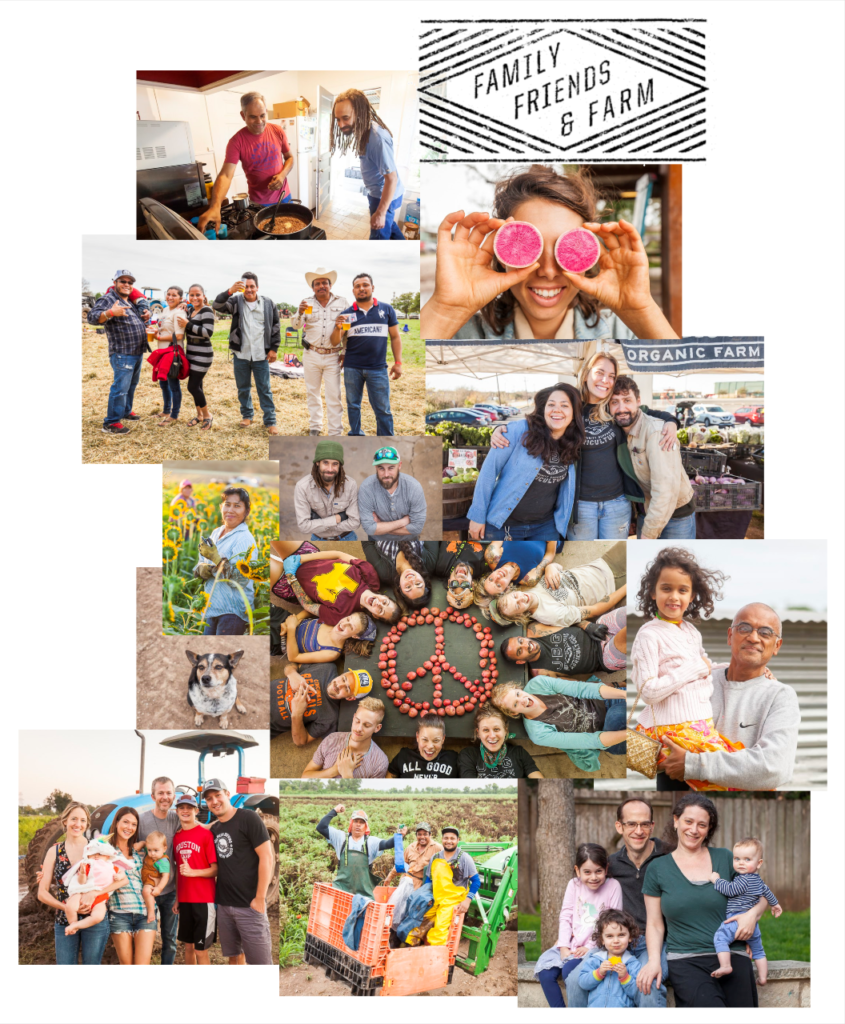
Hello All! Happy New Year! It's been quite the year. Here is a recap of what the year was like for us at the farm.
Every January we run a promotion and invite new members into our CSA Program. If you're already a member, thank you for your support! Please help us out this January and tell your friends and family about this promotion. If they join within the month, we'll tack on an additional (free) CSA share to their subscription. All they need to do is enter FAMILY and checkout. If you're not a current member, you can JOIN HERE, enter FAMILY at checkout, and enjoy some free veggies.
We are wishing you a bright and joyful 2021. We look forward to continuing to grow and harvest a rainbow of organic vegetables for you and your family. As always, don't hesitate to reach out if you have any questions or just want to say hi. We love to hear from you.
With gratitude and love,
Your JBG Farmers
WINTER VEGGIE SWEET HEAT
01/07/21 — Ada Broussard
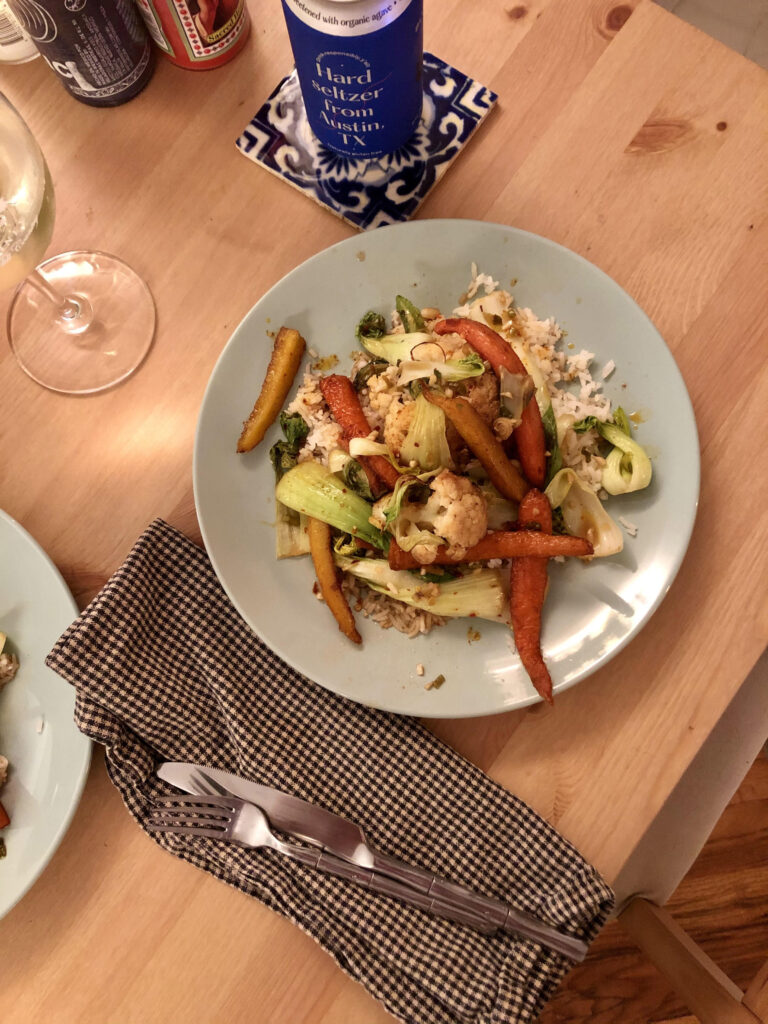 Recipe and photo by Heydon & Isaac.
Recipe and photo by Heydon & Isaac.
This recipe came at the end of a shocking day… and our oven, well euphemistically speaking, is inconsistent... so we had to improvise. Regardless of everything, it was delicious and nourished our worn-out little bodies and minds. The recipe below was how we envisioned it going, but we ended up solely using the stovetop for our version. JBG’s famous carrots bathed in the limelight of the meal with their vibrant hues, while the cauliflower and baby bok choy delivered award-worthy supporting roles. I’ve been watching too much TV in quarantine, obviously.
Ingredients:
- A bunch of carrots
- A few Cauliflower florets
- A couple of heads of baby bok choy
- Honey
- Salt
- Cayenne
- Butter
- Your preferred cooking oil
Sauce ingredients:
- 1/4 cup ponzu sauce
- One tablespoon soy sauce
- One tablespoon rice vinegar
- One or two teaspoons fish sauce
- 2-3 cloves garlic, finely chopped
- 3 green onions, finely chopped
Directions:
Preheat oven to 400 degrees. In a small bowl, stir to combine the sauce ingredients.
Cut carrots into halves or fourths depending on size. Place onto an oven pan and add a generous amount of butter, honey, cayenne, & salt. Bake at 400 degrees until soft with a crispy outside. Once out of the oven you may sprinkle a bit more salt and cayenne to taste.
Make a few small cups of tin foil. Put a piece of butter at the bottom of each little cup and set small cauliflower heads into them. Spoon some of the sauce (3-4 spoonfuls) on top of the cauliflower. Bake at 400 degrees until the tops are brown and crispy.
Once the oven veggies are finished, pan fry the baby bok choy with whatever cooking oil you prefer, and pour all the remaining sauce into the pan. Cook with the lid on once the pan heats up for a minute or two. Plate the cauliflower and carrots on a bed of rice, and top with the bok choy & sauce. Enjoy.
5 COMPELLING REASONS TO JOIN OUR CSA
01/08/21 — Ada Broussard
It’s the new year, and if you’re like us, you’re feeling energized and excited about the possibilities for something fresh, new, and different this year. We might be biased… okay, yes, we’re definitely biased, but we think incorporating some local and seasonal veggies into your cooking routine is an incredible way to welcome in 2021. This past year put our farm and our farm family to the test (LINK), but we were able to meet the demands the pandemic posed to our business with creativity and perseverance, and our farm family feels stronger than ever heading into this new year. If you’ve never experienced the comfort and warm-fuzzies that come along with buying your veggies from a farm and source you actually know, now is the time to give it a try! Welcome to the family!
![]()
![]()
![]()
![]()
![]() Some of our CSA Members enjoy a farm tour... back when we hosted farm tours! Fingers crossed we can make one happen this year.
Some of our CSA Members enjoy a farm tour... back when we hosted farm tours! Fingers crossed we can make one happen this year.
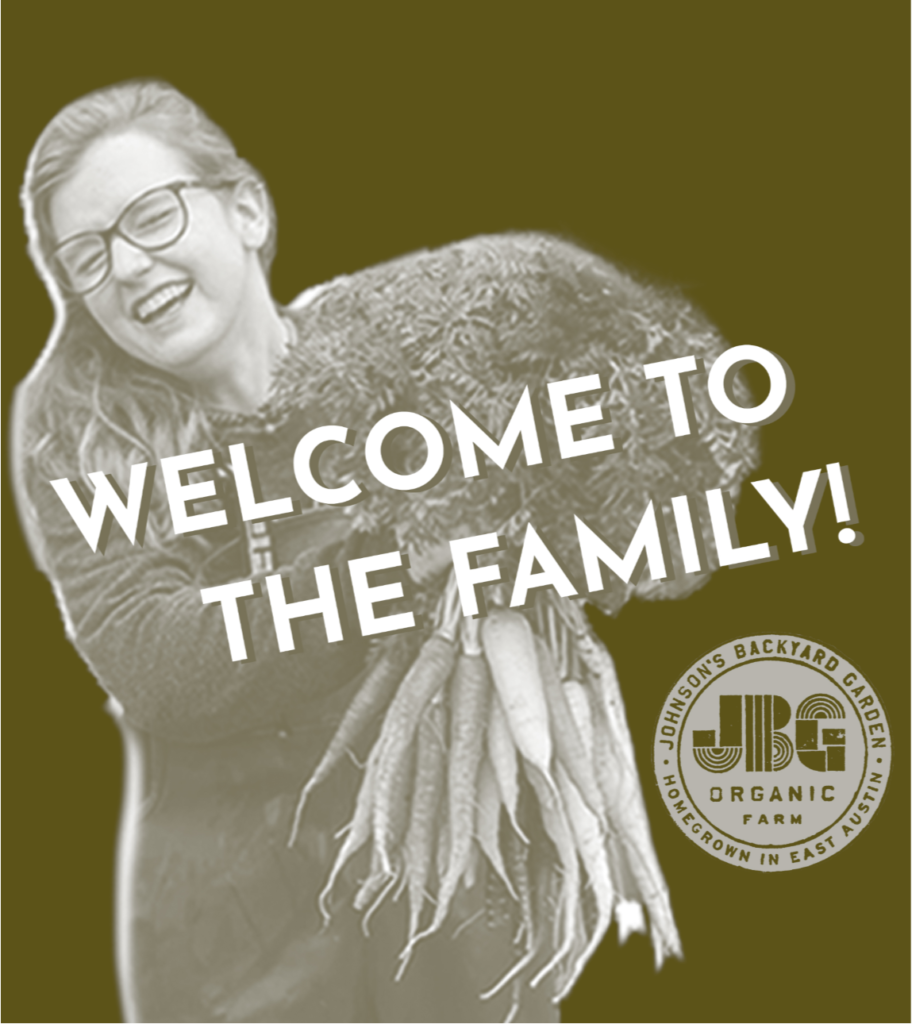
Five Reasons to Join our CSA in 2021:
1. FREE VEG:
If you join during the month of January, we’ll give you a free box. We repeat - free organic vegetables from your local farm! It’s an offer we only make once a year, so don’t procrastinate. Enter FAMILY at checkout and you’ll notice that an additional box has been added to your order. Shoot us an email with any questions - farm@jbgorganic.com.2. VARIETY. COLOR. VEGETABLES.
When you join the CSA, you align yourself with the Texas seasons and the diverse array of vegetables we can grow here like sweet and spicy radishes and alien-like kohlrabi. Eating these new-to-you veggies will expand your culinary prowess and connect you to the ways temperature, rain, and sunshine dictate the crops we can grow and the food you will enjoy.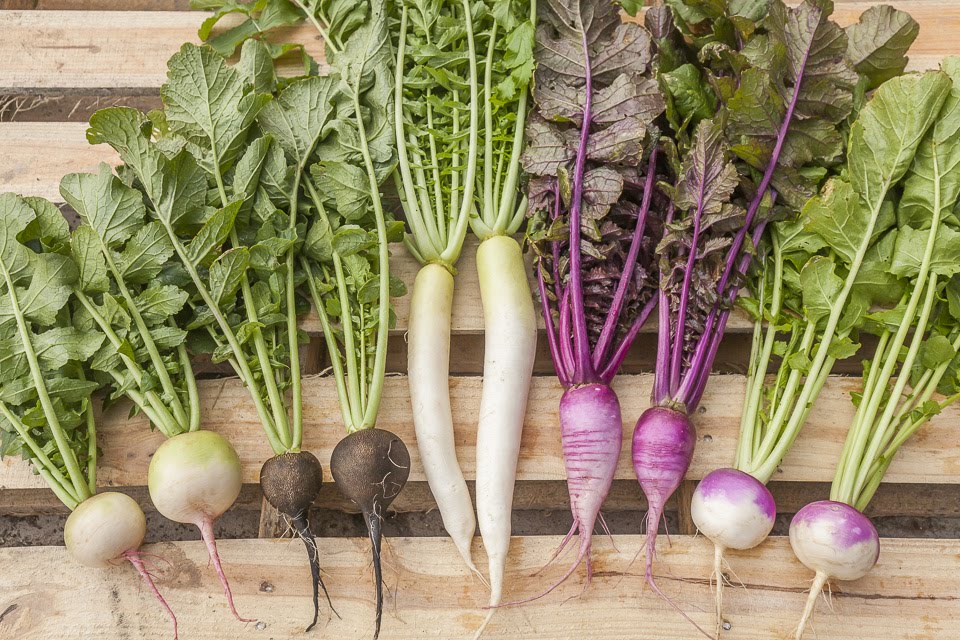
3. FRESHNESS
Vegetables you buy from the grocery store, or really from anywhere other than directly from a farmer, have to travel a good bit before they reach your kitchen. Most large grocery stores order huge pallets of vegetables, often from far-away-farms, that have to be trucked across the country (or from another country) to a regional warehouse. From there, individual grocery stores can place an order with their warehouse, and the product is again loaded on a truck, often traveling hundreds or thousands of miles to a grocery store cooler. Eventually, it gets put on a shelf, days, weeks, and sometimes months after the produce was harvested. When you join our CSA, your veggies make one trip: from our farm to your home. They skip all that transit which can reduce the quality and nutritive quality of vegetables. Vegetables from our farm arrive in your kitchen fresher, tastier, and devoid of a heavy carbon price tag.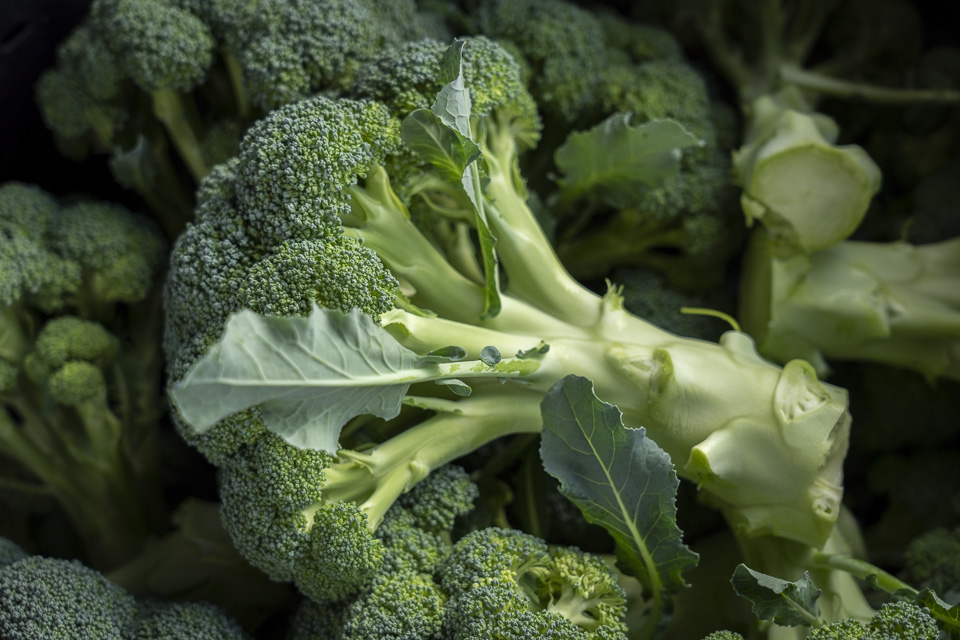
4. OPTIONS
Our CSA is full of options to make sure it can work with your cooking habits and family’s needs. Need a teeny-tiny box? That would be our individual size. Cooking for a crew? Get our large box. You can get your CSA share delivered every week, every other, or even on a more random schedule if you’d like. Login to your account and delay a delivery yourself, or just shoot us an email and we’ll take care of it. Lastly, we’re very proud to offer a customization feature with our CSA Program. With each delivery, you can swap out two veggies you don’t want for ones you’d prefer.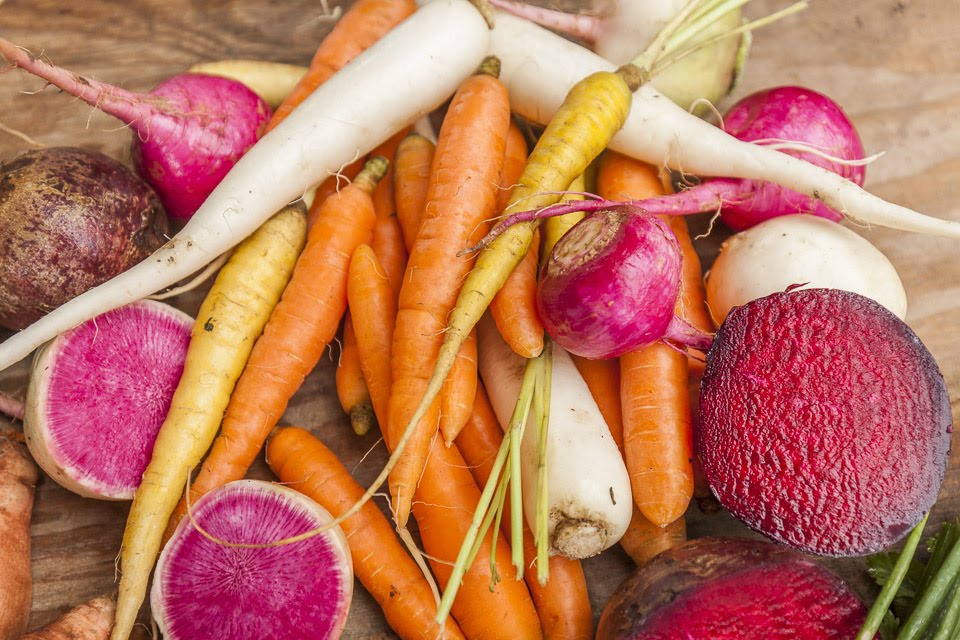
5. WARM-FUZZIES
When you join our CSA, you are essentially becoming a part of our beautiful farm family which includes our staff in the fields, planting and harvesting produce, our staff who carefully sorts and washes the veggies, our team of delivery drivers, our farmers’ market employees, as well as all of our customers who live in corners of Cental Texas like Plano, Georgetown, New Braunfels, and South Manchaca. We’ve been farming and partnering with our community since 2004, and these days it feels like our farm is truly its “best self”. We hope you’ll join the fam in 2021. We can’t wait to grow some veg for you!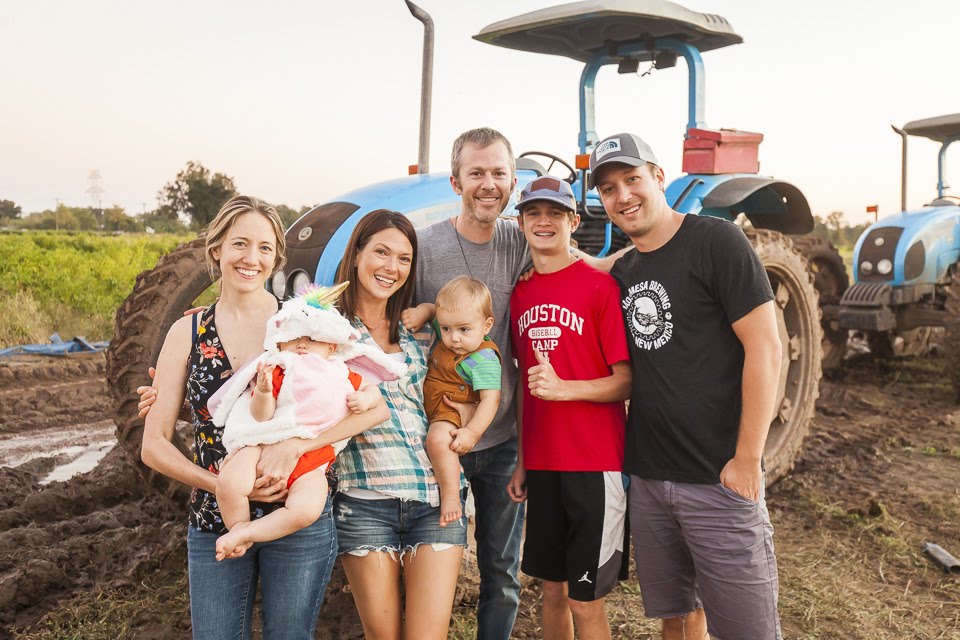 Some of our CSA Members enjoy a farm tour... back when we hosted farm tours! Fingers crossed we can make one happen this year.
Some of our CSA Members enjoy a farm tour... back when we hosted farm tours! Fingers crossed we can make one happen this year.
PHOTOS FROM THE FARM: 1.8.21
01/08/21 — Ada Broussard
Happy New Year, everyone! We're so excited to bring you 2021's first installment of farm photos. The turn of the calendar has us feeling fresh, excited, and energized to farm. And goodness knows we need the energy... there is a lot to do! It's this time of year, when we're planting onions and garlic and harvesting winter crops, that our mind begins to wander to warmer days and spring tasks. It will be here before we know it! In fact, we've already received most of our seed for our spring crop plan as well as for our spring transplant sale. Will you be planting a spring garden this year? It's a great time to begin to prep! Scroll below to see the beautiful photos our photographer, Scott David Gordon, captured at the farm.
![]() You eat the stems, right? Photo by Scott David Gordon.
You eat the stems, right? Photo by Scott David Gordon.
![]() Blue, green, and orange are the colors of this week's carrot harvest. Photo by Scott David Gordon.
Blue, green, and orange are the colors of this week's carrot harvest. Photo by Scott David Gordon.
![]() Our carrots are bunched in the field. There, the yellow leaves and too-small carrots are thrown to the ground, where they will eventually be tilled back into the soil. Photo by Scott David Gordon.
Our carrots are bunched in the field. There, the yellow leaves and too-small carrots are thrown to the ground, where they will eventually be tilled back into the soil. Photo by Scott David Gordon.
![]() Romaine, anyone? There has never been a better time to perfect your Cesar salad recipe. Give a homemade dressing a try, and we promise you won't regret it. Photo by Scott David Gordon.
Romaine, anyone? There has never been a better time to perfect your Cesar salad recipe. Give a homemade dressing a try, and we promise you won't regret it. Photo by Scott David Gordon.
![]() Kohlrabi means "cabbage turnip" in German, and these peculiar-looking vegetables are delicious eaten raw (in a slaw, like a cabbage), or throw in a stew, where they will soak up any flavors around them like pillowy sponges. Photo by Scott David Gordon.
Kohlrabi means "cabbage turnip" in German, and these peculiar-looking vegetables are delicious eaten raw (in a slaw, like a cabbage), or throw in a stew, where they will soak up any flavors around them like pillowy sponges. Photo by Scott David Gordon.
![]() Isabel planting leeks. Make sure you stretch before planting a long row of leeks - lots of bending involved in this farm task! Photo by Scott David Gordon.
Isabel planting leeks. Make sure you stretch before planting a long row of leeks - lots of bending involved in this farm task! Photo by Scott David Gordon.
![]() Drifting clouds revealing a bluebird sky. We've got a pretty office, don't you think? Photo by Scott David Gordon.
Drifting clouds revealing a bluebird sky. We've got a pretty office, don't you think? Photo by Scott David Gordon.
![]() Checkout the size of these parsley plants! They're more like hedges! Photo by Scott David Gordon.
Checkout the size of these parsley plants! They're more like hedges! Photo by Scott David Gordon.
![]() Marisol taming the wildly lush parsley into big, beautiful bunches. Unsure what to do with your parsley? Blend it up with olive oil, salt, and lemon juice for a delicious sauce... which topped with parmesan and stopped up with bread, or frozen for future delight! Photo by Scott David Gordon.
Marisol taming the wildly lush parsley into big, beautiful bunches. Unsure what to do with your parsley? Blend it up with olive oil, salt, and lemon juice for a delicious sauce... which topped with parmesan and stopped up with bread, or frozen for future delight! Photo by Scott David Gordon.
![]() The fractical pattern of romanesco cauliflower is wonderous! Photo by Scott David Gordon.
The fractical pattern of romanesco cauliflower is wonderous! Photo by Scott David Gordon.
![]() Crowns of broccoli, just harvested and laying there. Photo by Scott David Gordon.
Crowns of broccoli, just harvested and laying there. Photo by Scott David Gordon.
![]() We are thankful for sunny days and a well-oiled harvest trailer. See the arms that spread out over the rows? Keeps us from bending over quite so much! Photo by Scott David Gordon
We are thankful for sunny days and a well-oiled harvest trailer. See the arms that spread out over the rows? Keeps us from bending over quite so much! Photo by Scott David Gordon
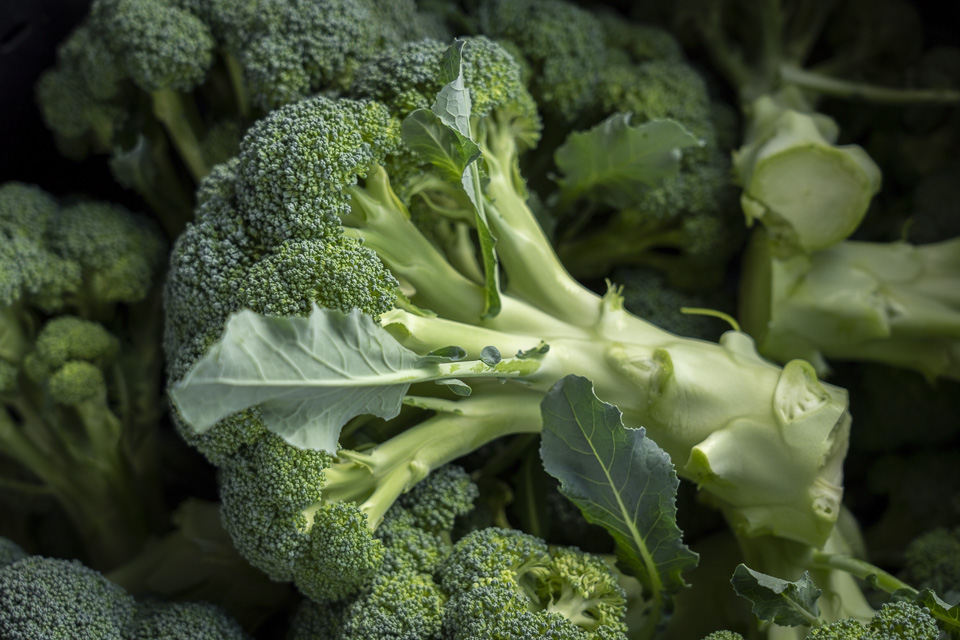 You eat the stems, right? Photo by Scott David Gordon.
You eat the stems, right? Photo by Scott David Gordon.
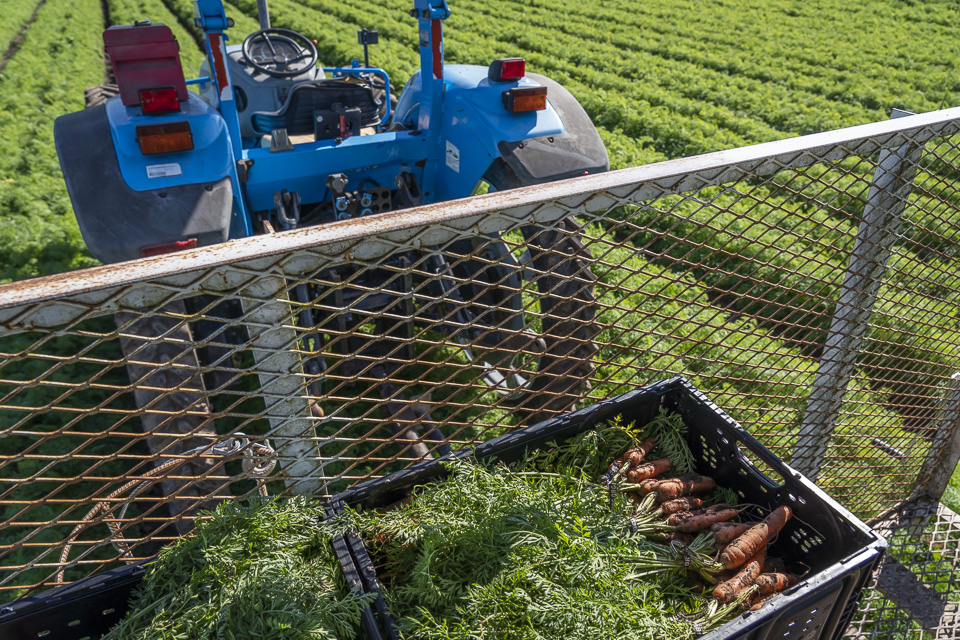 Blue, green, and orange are the colors of this week's carrot harvest. Photo by Scott David Gordon.
Blue, green, and orange are the colors of this week's carrot harvest. Photo by Scott David Gordon.
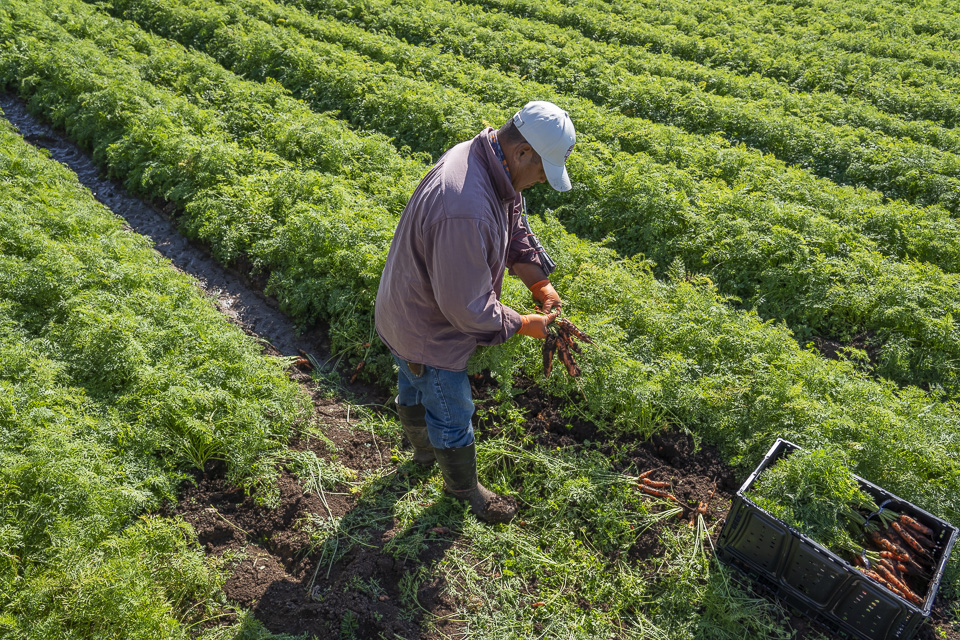 Our carrots are bunched in the field. There, the yellow leaves and too-small carrots are thrown to the ground, where they will eventually be tilled back into the soil. Photo by Scott David Gordon.
Our carrots are bunched in the field. There, the yellow leaves and too-small carrots are thrown to the ground, where they will eventually be tilled back into the soil. Photo by Scott David Gordon.
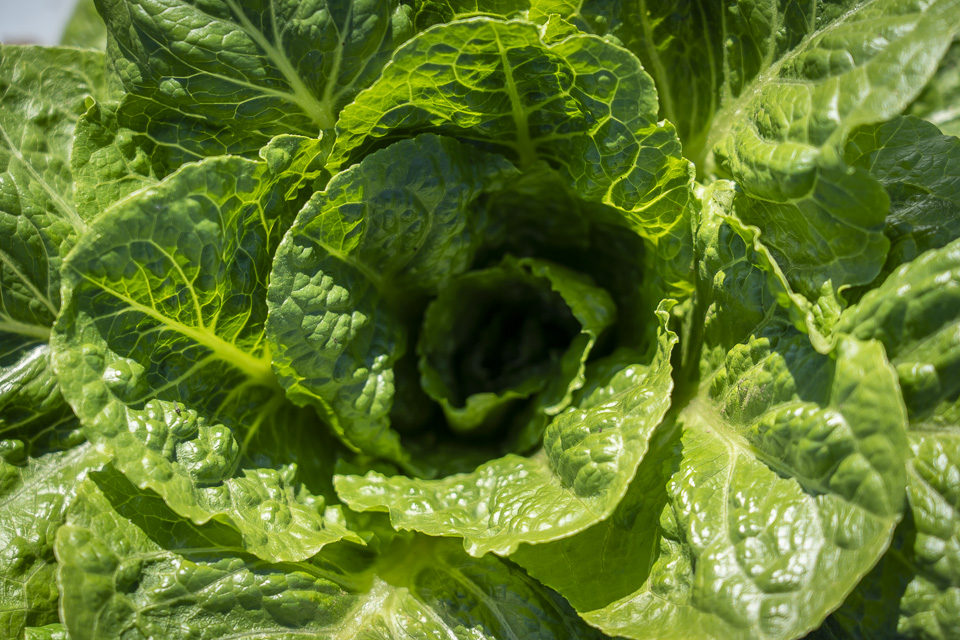 Romaine, anyone? There has never been a better time to perfect your Cesar salad recipe. Give a homemade dressing a try, and we promise you won't regret it. Photo by Scott David Gordon.
Romaine, anyone? There has never been a better time to perfect your Cesar salad recipe. Give a homemade dressing a try, and we promise you won't regret it. Photo by Scott David Gordon.
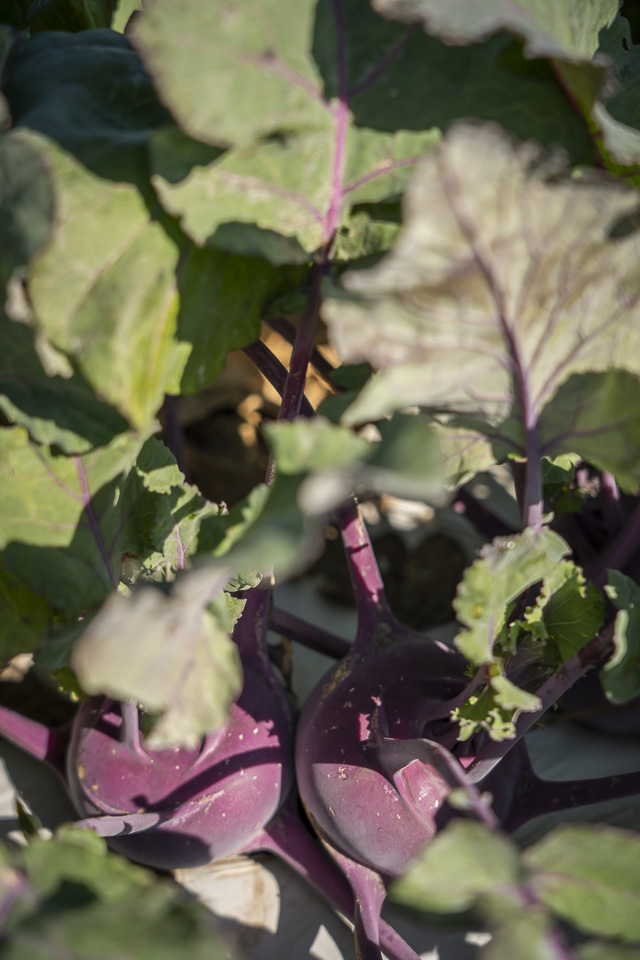 Kohlrabi means "cabbage turnip" in German, and these peculiar-looking vegetables are delicious eaten raw (in a slaw, like a cabbage), or throw in a stew, where they will soak up any flavors around them like pillowy sponges. Photo by Scott David Gordon.
Kohlrabi means "cabbage turnip" in German, and these peculiar-looking vegetables are delicious eaten raw (in a slaw, like a cabbage), or throw in a stew, where they will soak up any flavors around them like pillowy sponges. Photo by Scott David Gordon.
 Isabel planting leeks. Make sure you stretch before planting a long row of leeks - lots of bending involved in this farm task! Photo by Scott David Gordon.
Isabel planting leeks. Make sure you stretch before planting a long row of leeks - lots of bending involved in this farm task! Photo by Scott David Gordon.
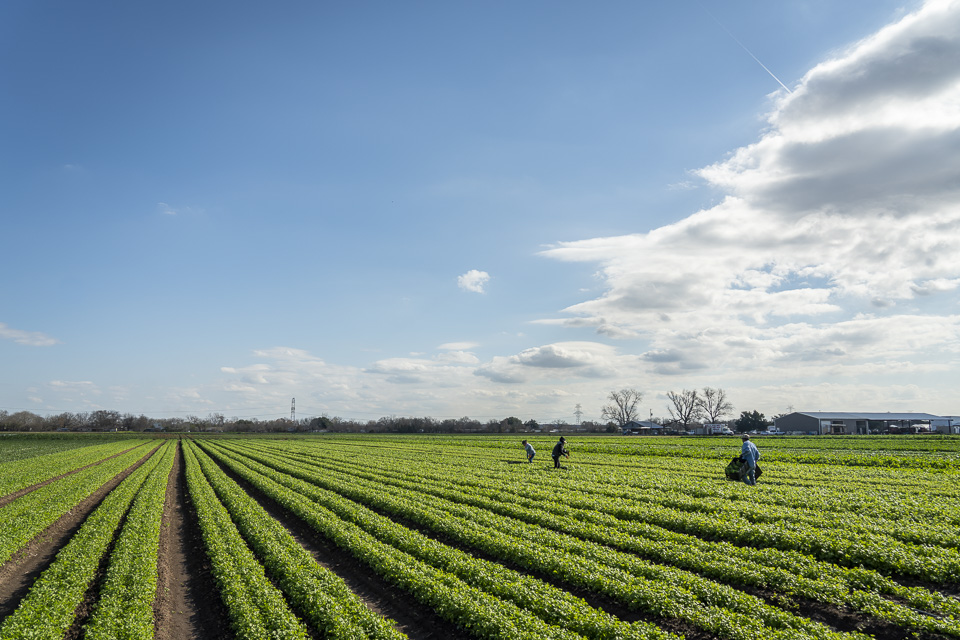 Drifting clouds revealing a bluebird sky. We've got a pretty office, don't you think? Photo by Scott David Gordon.
Drifting clouds revealing a bluebird sky. We've got a pretty office, don't you think? Photo by Scott David Gordon.
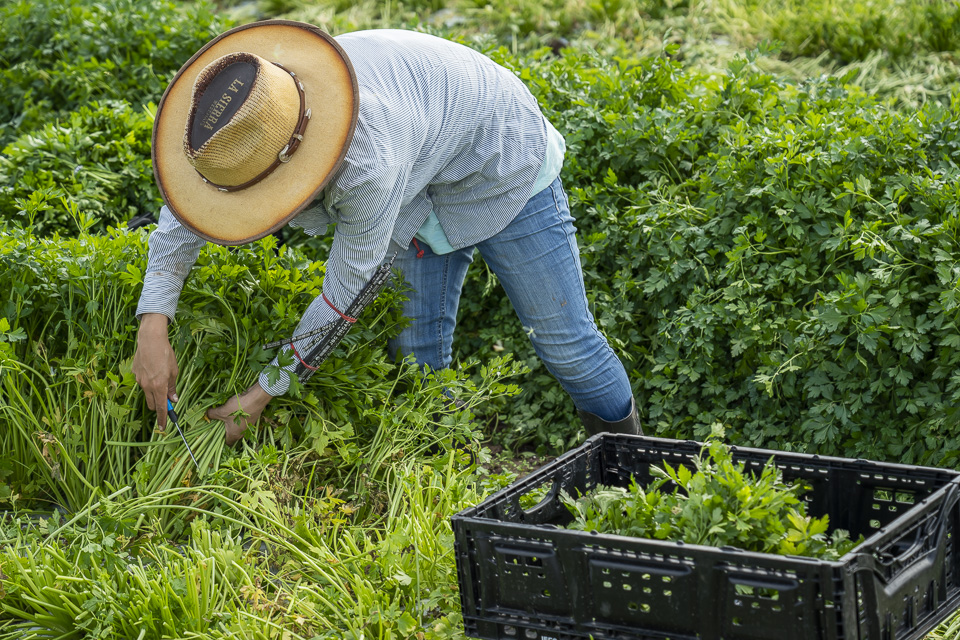 Checkout the size of these parsley plants! They're more like hedges! Photo by Scott David Gordon.
Checkout the size of these parsley plants! They're more like hedges! Photo by Scott David Gordon.
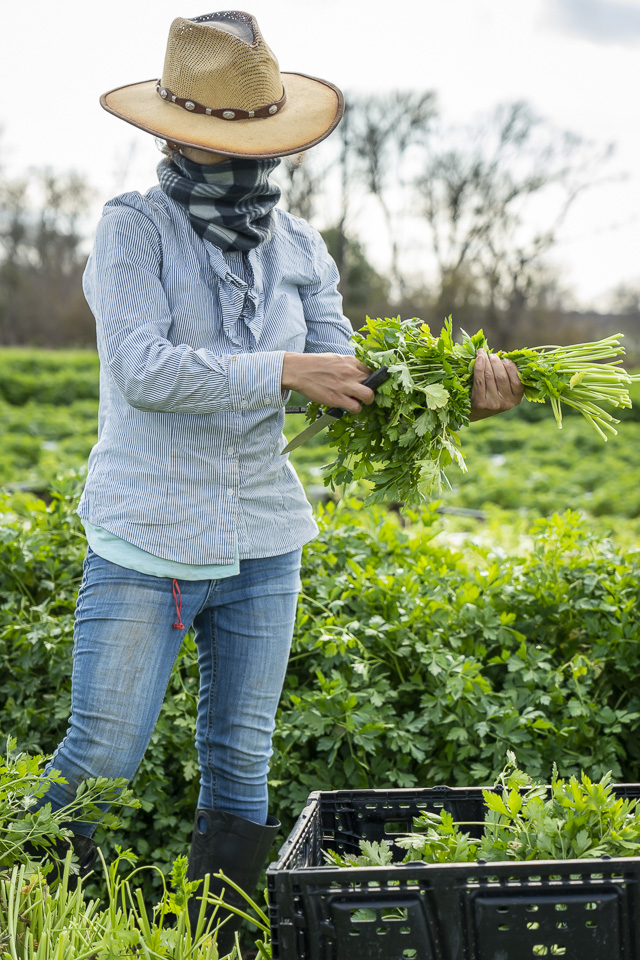 Marisol taming the wildly lush parsley into big, beautiful bunches. Unsure what to do with your parsley? Blend it up with olive oil, salt, and lemon juice for a delicious sauce... which topped with parmesan and stopped up with bread, or frozen for future delight! Photo by Scott David Gordon.
Marisol taming the wildly lush parsley into big, beautiful bunches. Unsure what to do with your parsley? Blend it up with olive oil, salt, and lemon juice for a delicious sauce... which topped with parmesan and stopped up with bread, or frozen for future delight! Photo by Scott David Gordon.
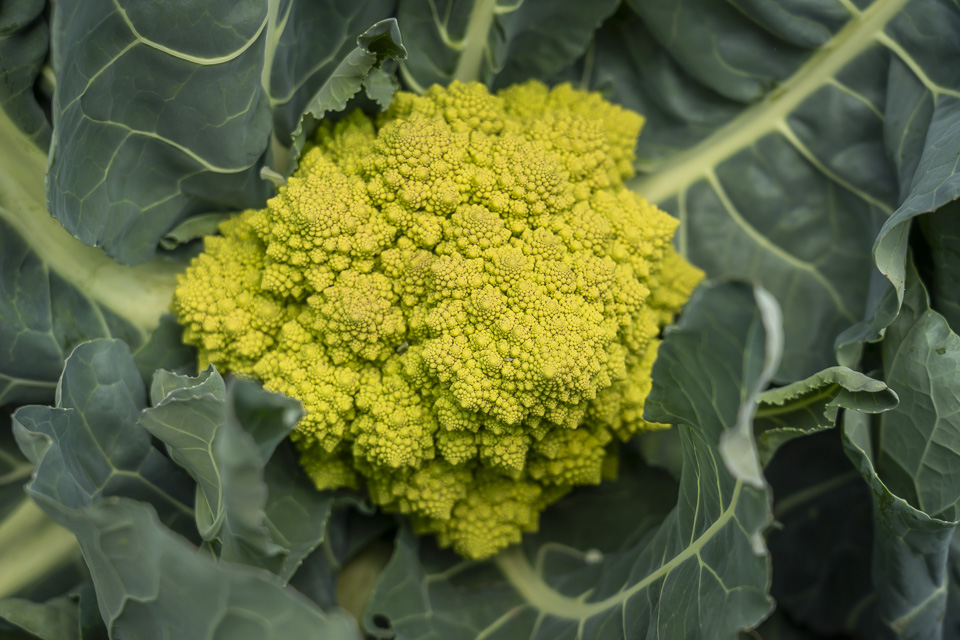 The fractical pattern of romanesco cauliflower is wonderous! Photo by Scott David Gordon.
The fractical pattern of romanesco cauliflower is wonderous! Photo by Scott David Gordon.
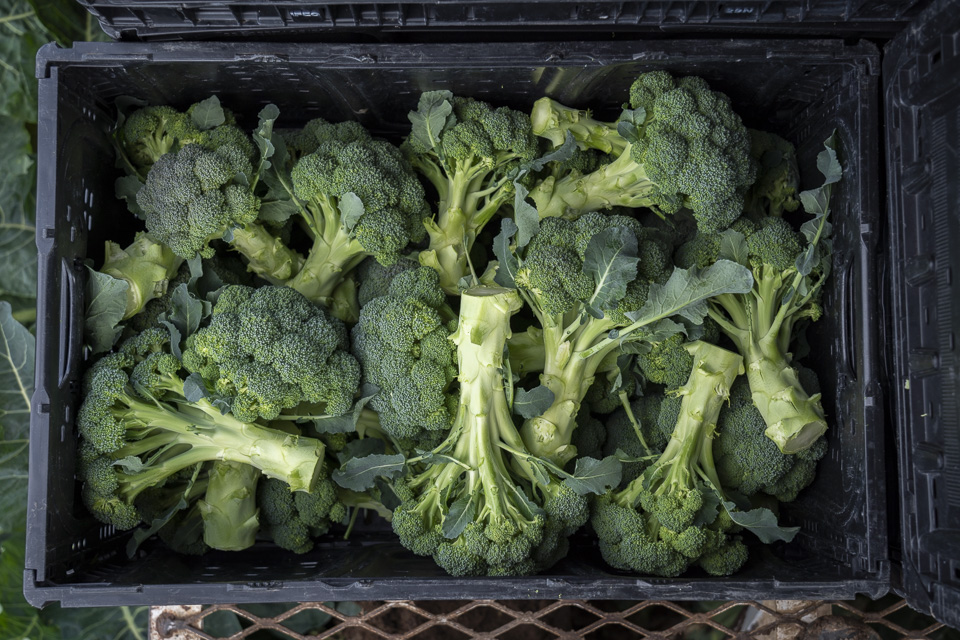 Crowns of broccoli, just harvested and laying there. Photo by Scott David Gordon.
Crowns of broccoli, just harvested and laying there. Photo by Scott David Gordon.
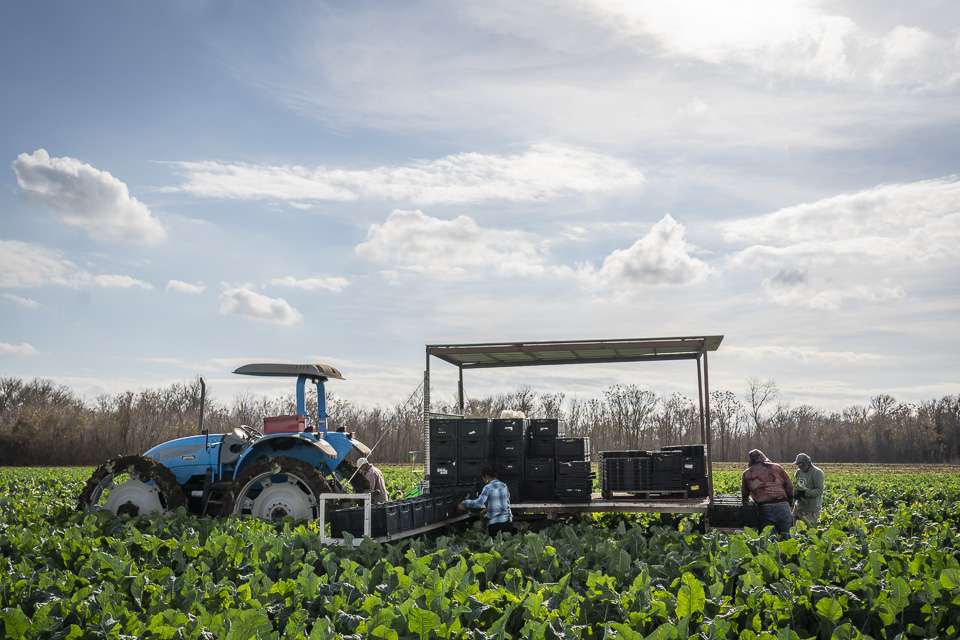 We are thankful for sunny days and a well-oiled harvest trailer. See the arms that spread out over the rows? Keeps us from bending over quite so much! Photo by Scott David Gordon
We are thankful for sunny days and a well-oiled harvest trailer. See the arms that spread out over the rows? Keeps us from bending over quite so much! Photo by Scott David GordonCSA BOX CONTENTS WEEK OF JAN 11TH
01/08/21 — Farm
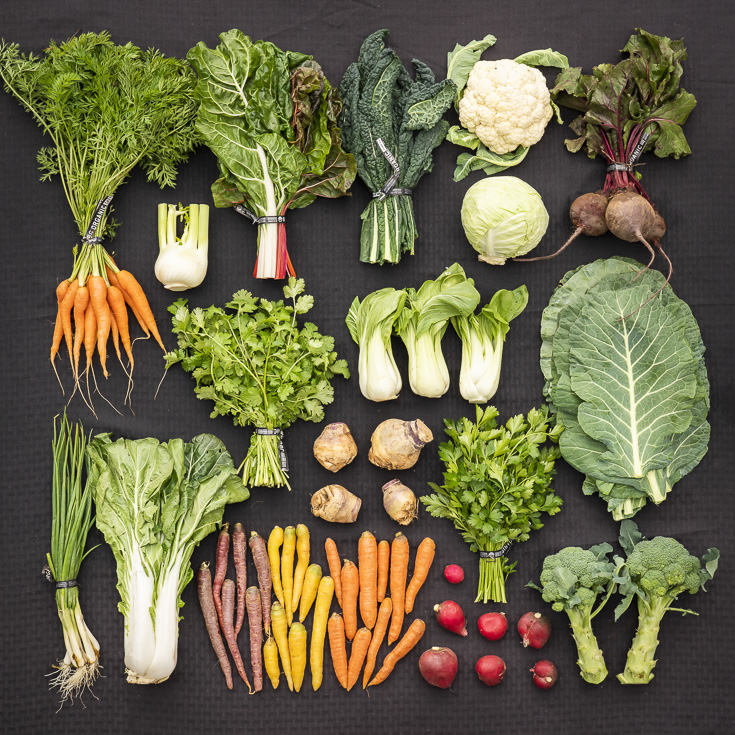 CSA Box Contents Week of Jan 11th
CSA Box Contents Week of Jan 11th
Large:
Cauliflower
Fennel
Dino Kale
Broccoli
Orange Carrot
Baby Bok Choi
Rutabaga
Swiss Chard
Cilantro
Cabbage
Beet
Collard Greens
CSA BOX CONTENTS WEEK OF JAN 11TH
01/08/21 — Farm
 CSA Box Contents Week of Jan 11th
CSA Box Contents Week of Jan 11th
Individual: Curly Kale, Swiss Chard, Carrot Bag, Cauliflower, Beet
Small: Curly Kale, Baby Bok Choi, Radish, Fennel, Farmer's Choice Herb, Rutabaga, Cauliflower
Medium: Cauliflower, Fennel, Dino Kale, Broccoli, Orange Carrot, Baby Bok Choi, Watermelon Radish, Swiss Chard, Cilantro, Beet
Large: Cauliflower, Fennel, Dino Kale, Broccoli, Orange Carrot, Baby Bok Choi, Rutabaga, Swiss Chard, Cilantro, Cabbage, Beet, Collard Greens
SUNSHINE SALAD
01/14/21 — Ada Broussard
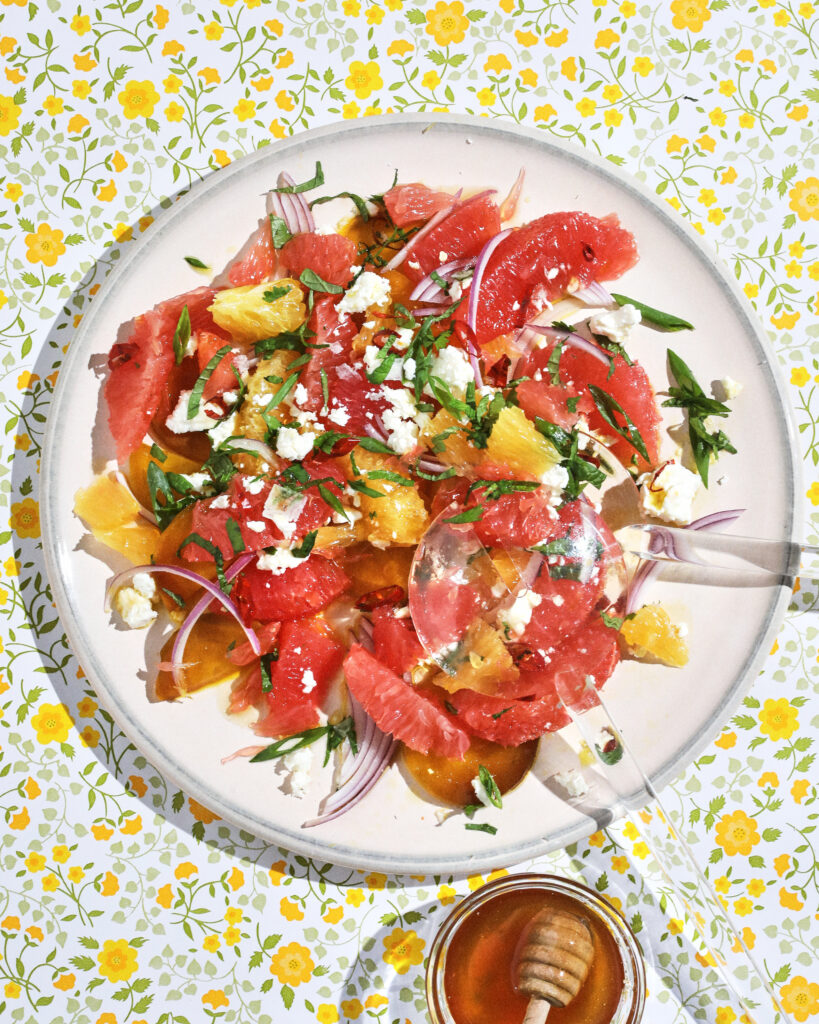 All Rights Reserved
All Rights Reserved
Photo and Story by Mackenzie Smith Kelley.
Last Tuesday, I took a PCR Covid test in preparation for a photoshoot I would be traveling for on Saturday. On Friday I received the results, fully expecting them to be negative before leaving town the next day. Unfortunately, that was not the case. The rapid test I took on Friday came back negative.
If I had just used the rapid test, left town and rode in the car with Maite, the food stylist for the photoshoot, then joined a crew full of people on set, I could have infected Maite and an entire group of people in another city.
Thankfully my symptoms have been relatively mild. We are ok. I am not doing great, but I am ok. Sleeping for 4-8 hours during the day, nagging headache, nausea. No respiratory issues.
I still can’t pinpoint where I contracted the virus, as we have taken every recommended precaution— and then some, to protect ourselves and our pod.
Echoing the words of Kristen Miglore, who found herself in a similar situation last month:
“I’m sharing this to add one more voice to the chorus of pleas: Take this more seriously than ever. Understand and honor the timelines of exposure, testing, and contagiousness. Whatever precautions you’ve let lapse over all these months—consider bringing them back. Lean on Zoom and FaceTime. Be patient—we will see each other again. Take care, for yourself, your loved ones, and our strained first responders.”
If you are counting on testing for an added level of safety before you are around other people, please consider skipping the rapid antigen test and building PCR tests into your schedule. It takes longer to receive the results, but in my case it is clearly worth the extra time. This article explains the difference between the two.
We are not even close to being out of the woods with this thing yet.
A few days before I received the dreaded positive PCR, began quarantine, and put myself to bed for a week, we got our CSA with an order citrus that included a big bag of oranges and a big bag of grapefruits. That afternoon, I made a sunny salad by supreming 2 of each citrus, sprinkling with confetti herbs, feta, dried chili and sea salt, then drizzling with olive oil and raw honey.
Symptoms didn’t really start to show up until after I received my positive test, and I haven’t had much of an appetite since then, but I have been forcing myself to drink a glass of OJ/grapefruit juice every day for all that locally grown vitamin C.
Below are the ingredients I used for the salad, but as always, I encourage you to use what you have and make it your own. Happy citrus season, y’all.
- 2 grapefruits, supremed
- 2 oranges, supreme
- 2 golden beets, steamed and sliced
- Mint & cilantro, chopped
- 2 scallions, thinly sliced
- Crumbled feta
- Drizzle of honey
- Drizzle of olive oil
- Dried chili pepper
- Flaky sea salt
WHAT ARE BRASSICAS, EXACTLY?
01/15/21 — Ada Broussard
As farm people, the word “Brassicas” is a regular player in our working dictionary of botany terms and tractor parts. Brassicas this, and Brassicas that. It’s a fun word to say and is particularly useful because it describes a large group of crops we grow. Seeing as you’re reading a farm blog right now, chances are you’re a lover of seasonal vegetables and a locavore, too. Does “Brassica” roll off your tongue with the confidence of a vegetable farmer? We think it should. Read on and you’ll realize that you already know these cruciferous vegetables. If you’re eating from a CSA box or JBG market haul, big and baby Brassicas alike have no doubt been on your plate more often this winter than not.
![]() Brenton with a few Brassicas.
Brenton with a few Brassicas.
Brassica is a genus of plants in the mustard family, or Brassicaceae in Latin, whose members are informally referred to as cruciferous vegetables, not to be confused with a crucifer, which has something to do with carrying a cross. The Brassica family contains many species and subspecies, several of which are responsible for growing some of the world’s most important agricultural crops. Brassicas love the cool weather, making them a late fall, winter, and early spring crop here in Central Texas. We push the seasonal windows with some of our Brassicas, but really - their time to shine is right this very instant.
So what the heck actually are Brassicas? The list of cruciferous vegetables we grow is long: kohlrabi, brussels sprouts, cabbages (all of them), broccoli, cauliflower, romanesco, turnips, bok choy, kale, collards, mustard greens, radishes, rutabaga, arugula, and all the diverse and specialty versions of those things you see on our spray tables. Did we forget one? Maybe… Brassicas rule over our winter crop plan with a partisan authority. Each one of these distinct but closely related vegetables was bred over the course of around 10,000 years by enterprising farmers all over the world making Brassicas one of the oldest cultivated crops we know of.
![]()
![]() We went to Brenton's Instagram (@farmerbrenton) because we know there was one photo of him with "the biggest brussel sprout" he's ever seen. We quickly realized that Brenton's Instagram is truly just a series of photos of Brenton with Brassicas over the years. He poses with no other plant family, it seems.
We went to Brenton's Instagram (@farmerbrenton) because we know there was one photo of him with "the biggest brussel sprout" he's ever seen. We quickly realized that Brenton's Instagram is truly just a series of photos of Brenton with Brassicas over the years. He poses with no other plant family, it seems.
Perhaps the most fascinating species of Brassica is Brassica oleracea which has undergone several rounds of domestication selection, all stemming (get it) from the same wild progenitor. If you’re interested in a botanical deep dive of this species, check out this blog post titled “The extraordinary diversity of Brassica oleracea” by Jeanne L. D. Osnas, a Ph.D. plant ecologist and evolutionary biologist. Who loves to cook. (Really, it’s an incredible blog.) Jeanne writes, “Some species have undergone the domestication process multiple times, and with some of these species, each domestication effort has focused on amplifying different structures of the plant...Such is the case with Brassica oleracea. The wild plant is a weedy little herb that prefers to grow on limestone outcroppings all around the coastal Mediterranean region. It is a biennial plant that uses food reserves stored over the winter in its rosette of leaves to produce a spike of a few yellow flowers at the end of its second summer before dying”.
Get ready to have your mind blown. Brassica oleracea makes up 9 of the vegetables we grow at JBG including red and green cabbage, broccoli, cauliflower, romanesco, Brussels sprouts (none this season, sorry), collards, kales, Savoy cabbage, and kohlrabi. Have you ever marveled at how Brussels sprouts just look like tiny cabbages? Or noticed that kohlrabi leaves taste a hell of a lot like collards? Deep down, you know that broccoli and cauliflower are deeply connected, but why does it all feel so familiar? It’s because it’s all the same plant! Check out the nifty chart below for a refresher on exactly what part of Brassica oleracea was selected to yield some of your favorite winter veggies.
![]() Graphic from Business Insider. One plant, many vegetables.
Graphic from Business Insider. One plant, many vegetables.
![]() Apparently, there is a meme for everything.
Apparently, there is a meme for everything.
![]()
We’re literally brimming in Brassicas right now, and each and everyone has an interesting evolution from a wild mustard weed blowing in the wind to a starchy root crop (turnip) or spicy leaf (arugula) or a bouquet of buds (broccoli). Enjoy your little Brassicals before it’s hot outside and they’ve flown the coop. Thanks for reading!
![]() Brassicas on Brassicas on Brassicas.
Brassicas on Brassicas on Brassicas.
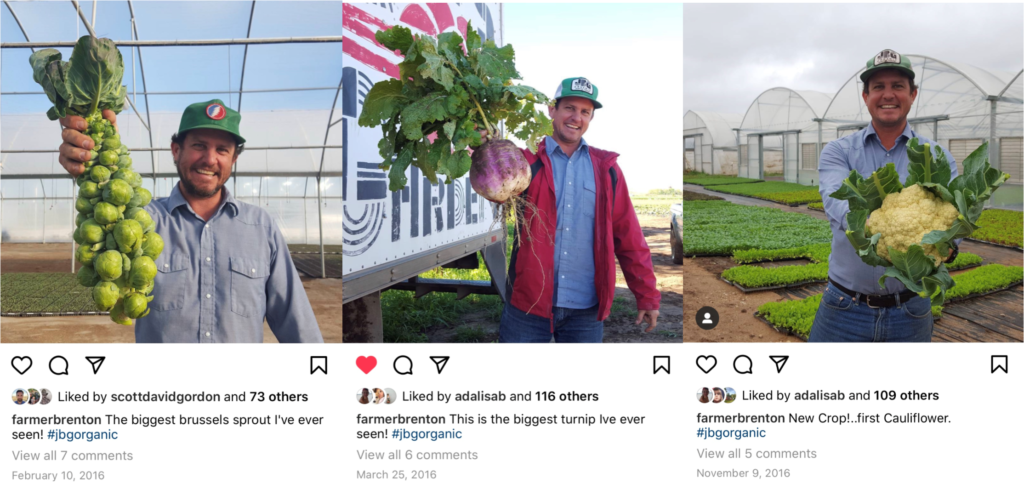 Brenton with a few Brassicas.
Brenton with a few Brassicas.
Brassica is a genus of plants in the mustard family, or Brassicaceae in Latin, whose members are informally referred to as cruciferous vegetables, not to be confused with a crucifer, which has something to do with carrying a cross. The Brassica family contains many species and subspecies, several of which are responsible for growing some of the world’s most important agricultural crops. Brassicas love the cool weather, making them a late fall, winter, and early spring crop here in Central Texas. We push the seasonal windows with some of our Brassicas, but really - their time to shine is right this very instant.
So what the heck actually are Brassicas? The list of cruciferous vegetables we grow is long: kohlrabi, brussels sprouts, cabbages (all of them), broccoli, cauliflower, romanesco, turnips, bok choy, kale, collards, mustard greens, radishes, rutabaga, arugula, and all the diverse and specialty versions of those things you see on our spray tables. Did we forget one? Maybe… Brassicas rule over our winter crop plan with a partisan authority. Each one of these distinct but closely related vegetables was bred over the course of around 10,000 years by enterprising farmers all over the world making Brassicas one of the oldest cultivated crops we know of.
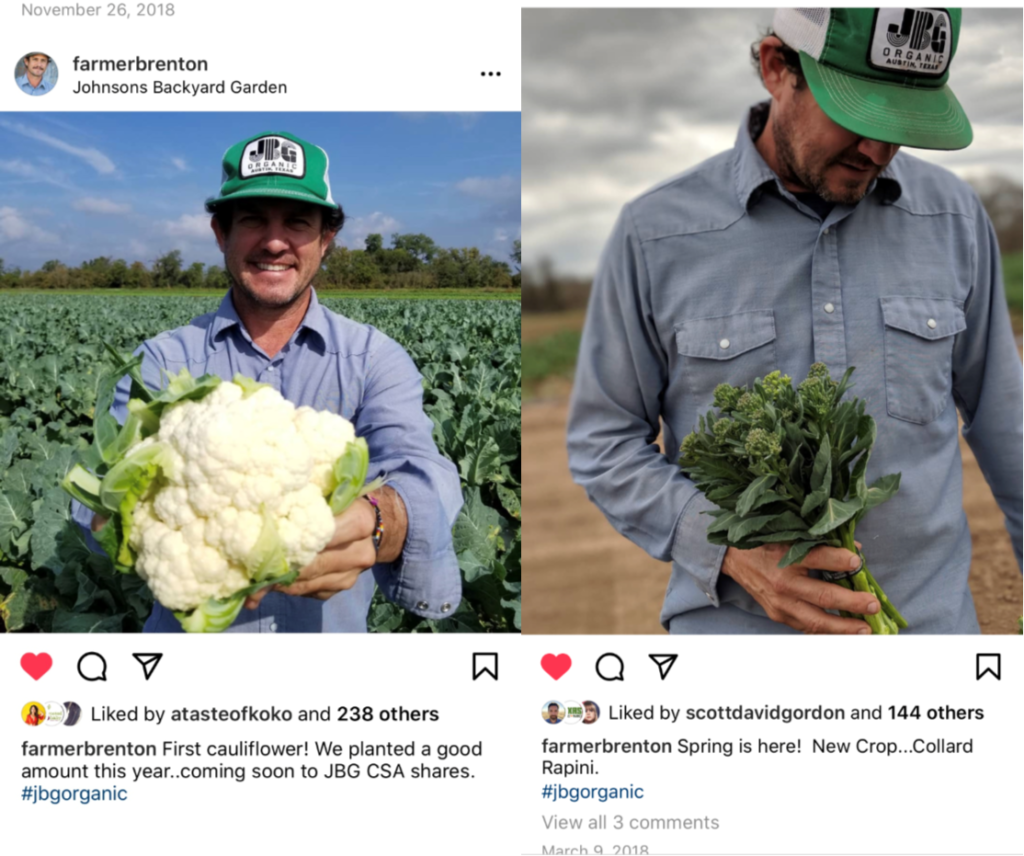
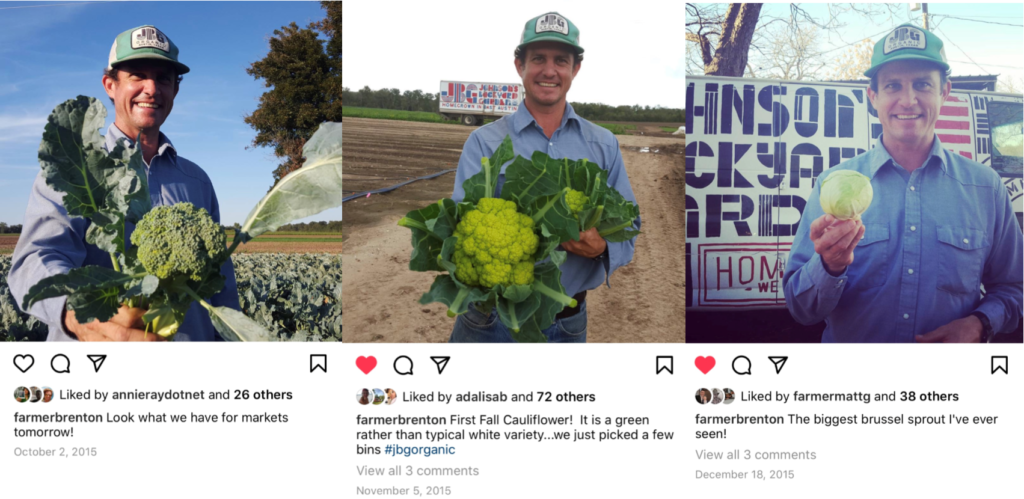 We went to Brenton's Instagram (@farmerbrenton) because we know there was one photo of him with "the biggest brussel sprout" he's ever seen. We quickly realized that Brenton's Instagram is truly just a series of photos of Brenton with Brassicas over the years. He poses with no other plant family, it seems.
We went to Brenton's Instagram (@farmerbrenton) because we know there was one photo of him with "the biggest brussel sprout" he's ever seen. We quickly realized that Brenton's Instagram is truly just a series of photos of Brenton with Brassicas over the years. He poses with no other plant family, it seems.
Perhaps the most fascinating species of Brassica is Brassica oleracea which has undergone several rounds of domestication selection, all stemming (get it) from the same wild progenitor. If you’re interested in a botanical deep dive of this species, check out this blog post titled “The extraordinary diversity of Brassica oleracea” by Jeanne L. D. Osnas, a Ph.D. plant ecologist and evolutionary biologist. Who loves to cook. (Really, it’s an incredible blog.) Jeanne writes, “Some species have undergone the domestication process multiple times, and with some of these species, each domestication effort has focused on amplifying different structures of the plant...Such is the case with Brassica oleracea. The wild plant is a weedy little herb that prefers to grow on limestone outcroppings all around the coastal Mediterranean region. It is a biennial plant that uses food reserves stored over the winter in its rosette of leaves to produce a spike of a few yellow flowers at the end of its second summer before dying”.
Get ready to have your mind blown. Brassica oleracea makes up 9 of the vegetables we grow at JBG including red and green cabbage, broccoli, cauliflower, romanesco, Brussels sprouts (none this season, sorry), collards, kales, Savoy cabbage, and kohlrabi. Have you ever marveled at how Brussels sprouts just look like tiny cabbages? Or noticed that kohlrabi leaves taste a hell of a lot like collards? Deep down, you know that broccoli and cauliflower are deeply connected, but why does it all feel so familiar? It’s because it’s all the same plant! Check out the nifty chart below for a refresher on exactly what part of Brassica oleracea was selected to yield some of your favorite winter veggies.
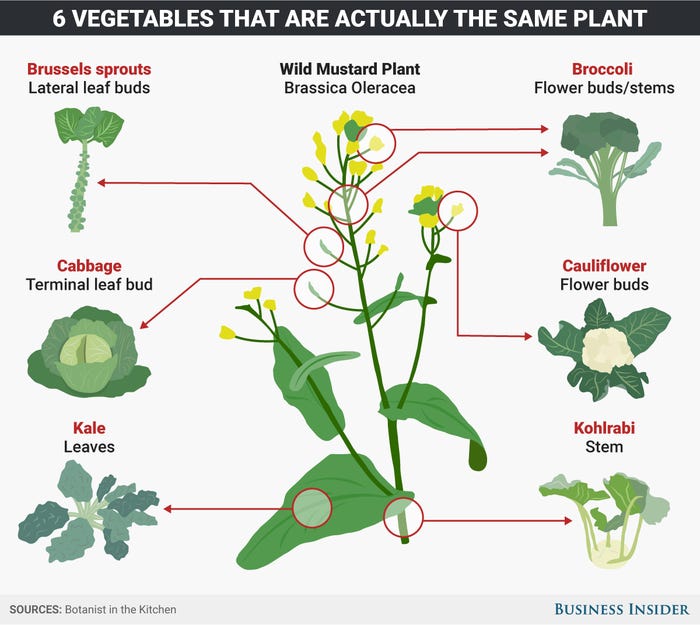 Graphic from Business Insider. One plant, many vegetables.
Graphic from Business Insider. One plant, many vegetables.
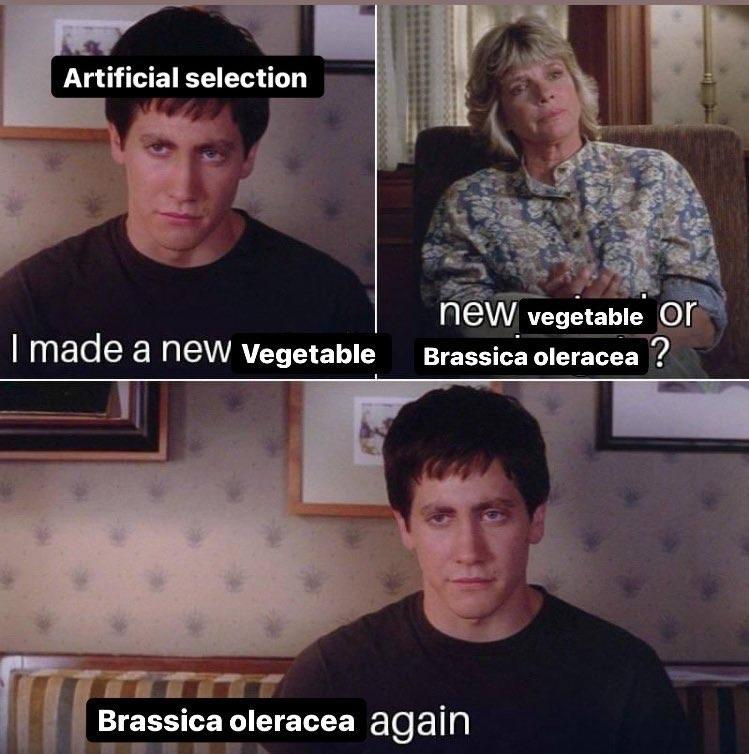 Apparently, there is a meme for everything.
Apparently, there is a meme for everything.

We’re literally brimming in Brassicas right now, and each and everyone has an interesting evolution from a wild mustard weed blowing in the wind to a starchy root crop (turnip) or spicy leaf (arugula) or a bouquet of buds (broccoli). Enjoy your little Brassicals before it’s hot outside and they’ve flown the coop. Thanks for reading!
 Brassicas on Brassicas on Brassicas.
Brassicas on Brassicas on Brassicas.CSA BOX CONTENTS WEEK OF JAN 18TH
01/15/21 — Farm
 CSA Box Contents Week Of Jan 18th
CSA Box Contents Week Of Jan 18th
Large:
Purple Cabbage
Orange Carrot
Baby Bok Choy
Broccoli
Kohlrabi
Chioggia Beet
Collard Greens
Curly Kale
Lettuce
Farmer's Choice Herb
Daikon Radish
Cauliflower
CSA BOX CONTENTS WEEK OF JAN 18TH
01/15/21 — Farm
 CSA Box Contents Week Of Jan 18th
CSA Box Contents Week Of Jan 18th
Individual: Purple Cabbage, Baby Bok Choy, 2lb Carrot, Broccoli, Collard Greens, Fennel
Small: Purple Cabbage, Orange Carrot, Broccoli, Dinosaur Kale, Kohlrabi, Beet, Collard Greens, Farmer's Choice Herb
Medium: Purple Cabbage, Orange Carrot, Kohlrabi, Chioggia Beet, Bok Choy, Lettuce, Farmer's Choice Herb, Scarlett Turnip, farmer's Choice Kale, Collard Greens
Large: Purple Cabbage, Orange Carrot, Baby Bok Choy, Broccoli, Kohlrabi, Chioggia Beet, Collard Greens, Curly Kale, Lettuce, Farmer's Choice Herb, Daikon Radish, Cauliflower
FIVE RECIPES FOR A FRESH START
01/22/21 — Ada Broussard
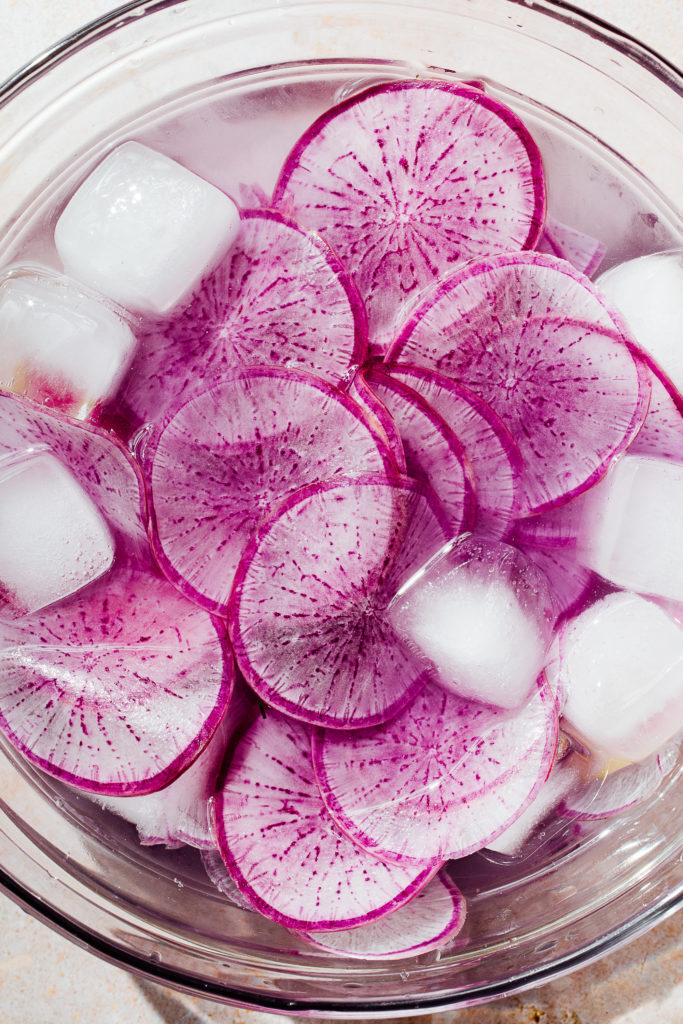 Purple daikons chillin' and crispin'. Photo and recipe by Mackenzie Smith Kelley.
Purple daikons chillin' and crispin'. Photo and recipe by Mackenzie Smith Kelley.
Is it just us, or do things feel fresher and lighter? Like 2021 can, in fact, be the year where we achieve some goals, love our neighbors, and support our farmers. Our rubber boots feel light despite the years of mud, and the seasons ahead looks bright. We’re farmers, and so we can’t help but approach the impending months with a feeling of optimism and excitement. Our greenhouse is about to be standing room only, thousands and thousands of seeds, tucked away in tiny cells, prodded to germinate and produce not only a bountiful spring harvest for the farm but also a vast inventory for our spring transplant sale (which will happen both online and in-person, at our greenhouse). It’s not too early to begin prepping your garden spaces! In celebration of these feelings of levity and bountiful opportunity, we thought we’d share 5 light recipes to inspire your plate and your path. It’s Texas salad season, after all!
 Sunshine salad story and photo by Mackenzie Smith Kelley. All Rights Reserved
Sunshine salad story and photo by Mackenzie Smith Kelley. All Rights Reserved
SUNSHINE SALAD
In addition to being salad season, it’s also citrus season and here at JBG we have access to the freshest Texas citrus harvested in the Rio Grande Valley. This citrus-salad recipe is also a story about Covid, which feels timely and important, and so we don’t mind sharing for the second week in a row.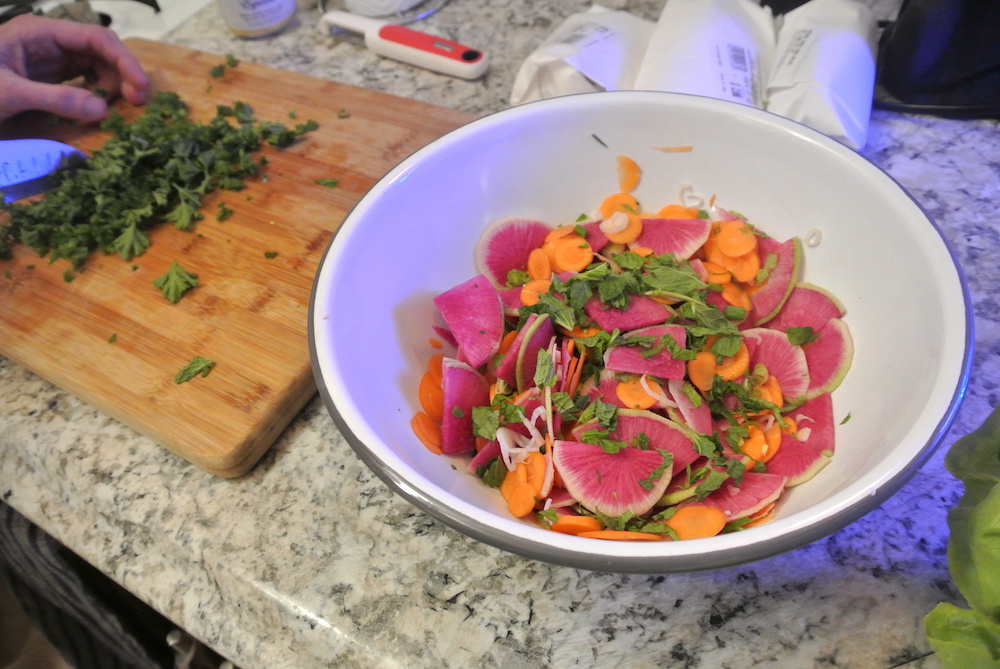 Photo and recipe by the dynamic duo, Heydon and Isaac.
Photo and recipe by the dynamic duo, Heydon and Isaac.
QUICK AND EASY LATE FALL SALAD
Despite the name, this salad will also work in the late winter. It’s been a mild season, and so many of our greens, roots, and herbs are still top-notch. This salad features a cohesive meeting of all of the above.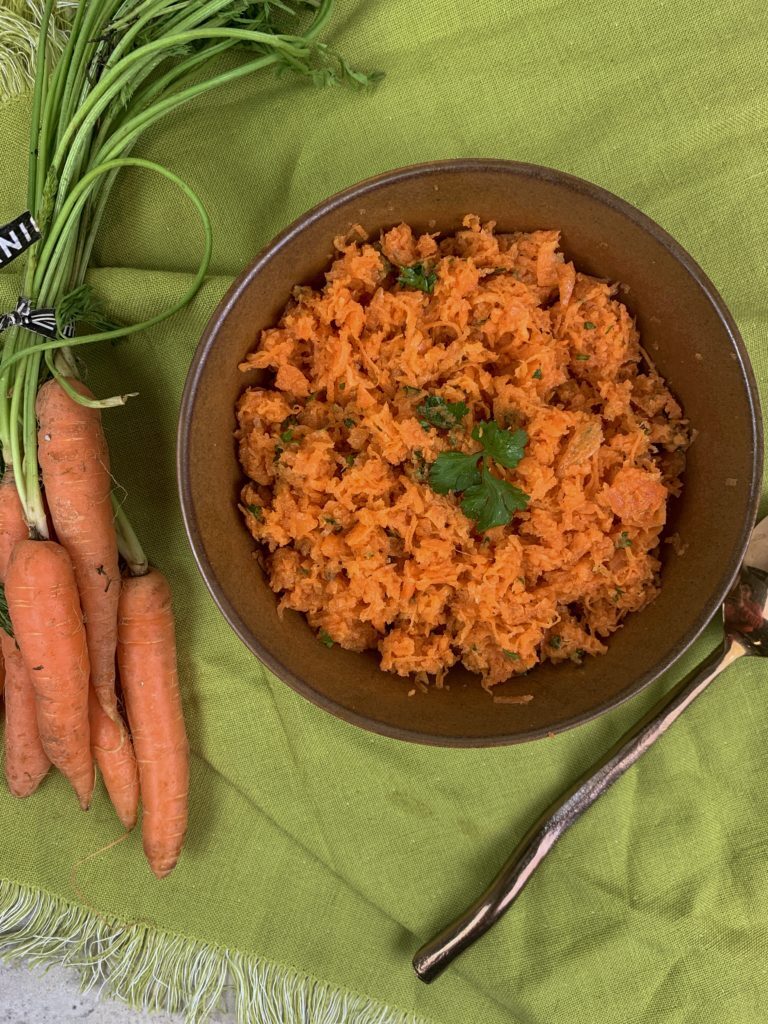 Photo and recipe by The Migoni Kitchen.
Photo and recipe by The Migoni Kitchen.
FRENCH GRATED CARROT SALAD
We love a recipe with a story, as well as one with a short ingredients list. This salad is inspired by Summer Migoni’s summers in France, visiting her grandparents. Here in Texas, carrots are a cool-season crop, so now is the time to make your own memories. Bon appétit.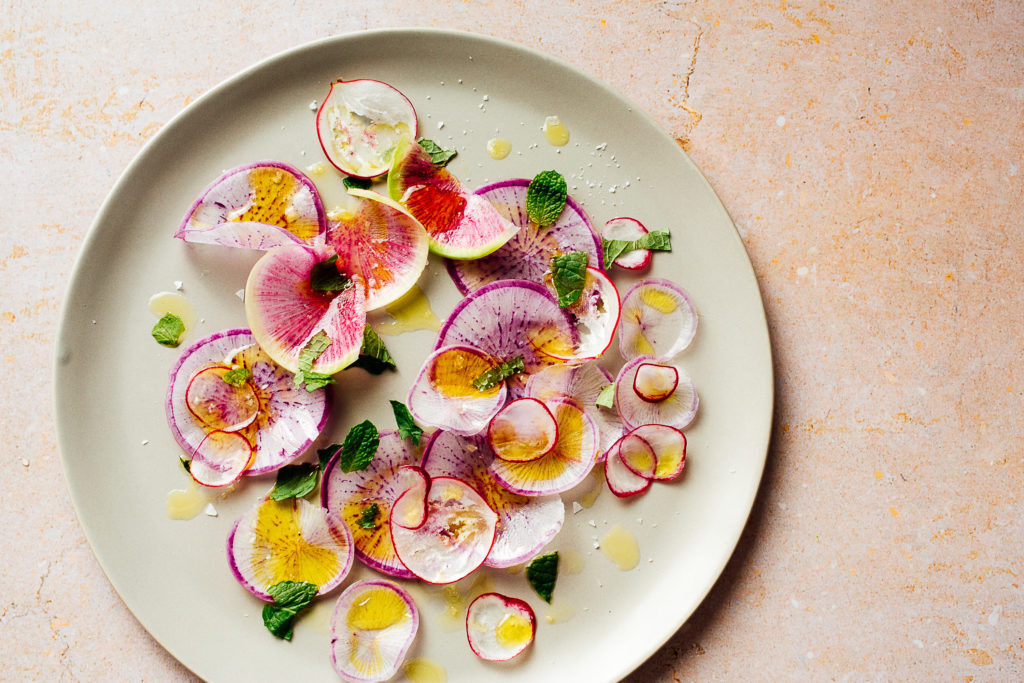 Plate assemblage and photo by Mackenzie Smith Kelley. All Rights Reserved.
Plate assemblage and photo by Mackenzie Smith Kelley. All Rights Reserved.
RADISH SALAD
We know you’ve been inundated with radishes lately, and we bet you’ve been topping all of your favorite dishes with the crunch and pep that they provide. But have you let your radishes shine this season, starring in their own show? This salad recipe will show you how simple it can be.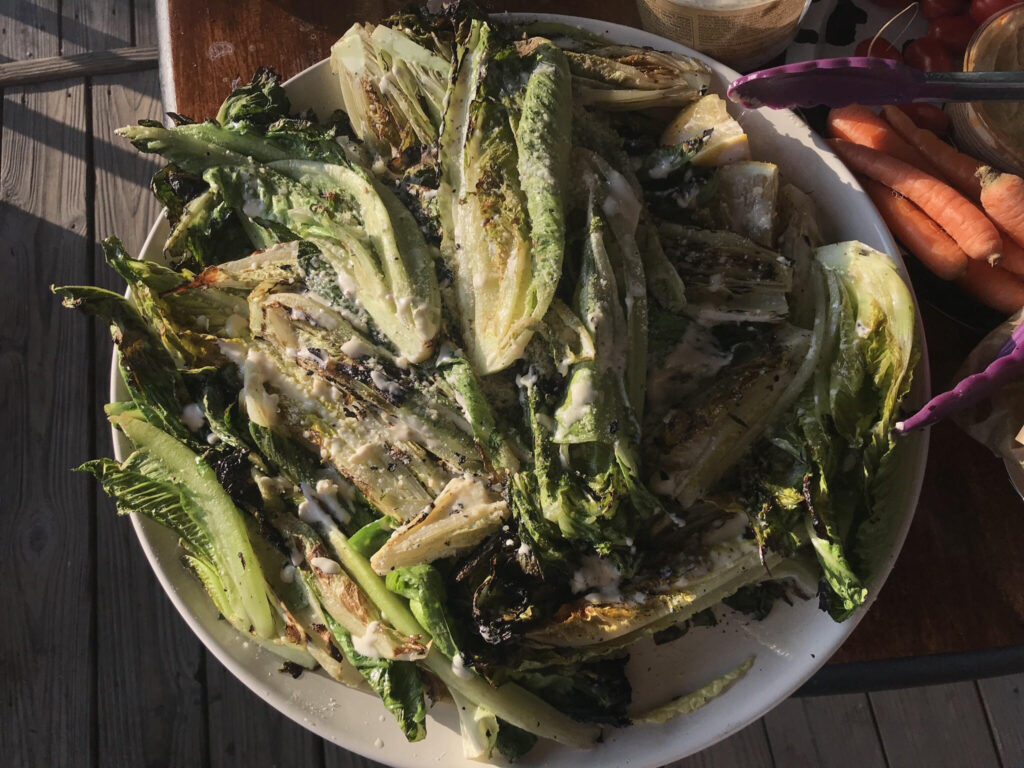
CESAR SALAD TWO WAYS
Is there anything more satisfying than a crisp, creamy, and umami-packed Cesar salad? Yes: it’s this salad prepared two ways, both versions with a homemade Cesar dressing that you could drink.PHOTOS FROM THE FARM: 1.22.21
01/22/21 — Ada Broussard
Did you know that if you join our CSA program by the end of this month, the first box is free? Simply enter JOINTHEFAM at checkout. And if you're curious what exactly goes into making our CSA boxes, take a gander at this week on the farm. There are beet, carrot, and cabbage clues.
![]() These golden beet greens are looking top notch. We love a bunched beet - it's truly two vegetables for the price of one. Photo by Scott David Gordon.
These golden beet greens are looking top notch. We love a bunched beet - it's truly two vegetables for the price of one. Photo by Scott David Gordon.
![]() If the quality of the greens is less desirable, beets get "topped" and harvested in bulk. Luckily, a few insect holes in the greens doesn't bother the roots one bit. Photo by Scott David Gordon.
If the quality of the greens is less desirable, beets get "topped" and harvested in bulk. Luckily, a few insect holes in the greens doesn't bother the roots one bit. Photo by Scott David Gordon.
![]() Purple top turnips in all shapes and sizes. Photo by Scott David Gordon.
Purple top turnips in all shapes and sizes. Photo by Scott David Gordon.
![]() Collard fans. Photo by Scott David Gordon.
Collard fans. Photo by Scott David Gordon.
![]() Did you read last week's blog post on brassicas? DId you know that a head of cabbage is just an enlarged terminal bud? Photo by Scott David Gordon.
Did you read last week's blog post on brassicas? DId you know that a head of cabbage is just an enlarged terminal bud? Photo by Scott David Gordon.
![]() Speaking of Brassicas, believe it or not, this dino kale and a head of green cabbage are actually the same species of plant. Whereas the cabbage was selectively bread for a large bud, kale was bred for large leaves. Photo by Scott David Gordon.
Speaking of Brassicas, believe it or not, this dino kale and a head of green cabbage are actually the same species of plant. Whereas the cabbage was selectively bread for a large bud, kale was bred for large leaves. Photo by Scott David Gordon.
![]() The kale that keeps on giving. These kale plants have been harvested off of throughout the whole fall and winter season, and there is plenty more to go. Photo by Scott David Gordon.
The kale that keeps on giving. These kale plants have been harvested off of throughout the whole fall and winter season, and there is plenty more to go. Photo by Scott David Gordon.
![]() Cabbage patch women. Photo by Scott David Gordon.
Cabbage patch women. Photo by Scott David Gordon.
![]() Vicente uses the John Deere to skillfully stack the bulk bins of cabbage before loading them into the cooler. Photo by Scott David Gordon.
Vicente uses the John Deere to skillfully stack the bulk bins of cabbage before loading them into the cooler. Photo by Scott David Gordon.
![]() So orange, they almost look fake. Photo by Scott David Gordon.
So orange, they almost look fake. Photo by Scott David Gordon.
![]() Ginger in ultimate carrot concentration. Photo by Scott David Gordon.
Ginger in ultimate carrot concentration. Photo by Scott David Gordon.
![]() CSA box dreams. Photo by Scott David Gordon.
CSA box dreams. Photo by Scott David Gordon.
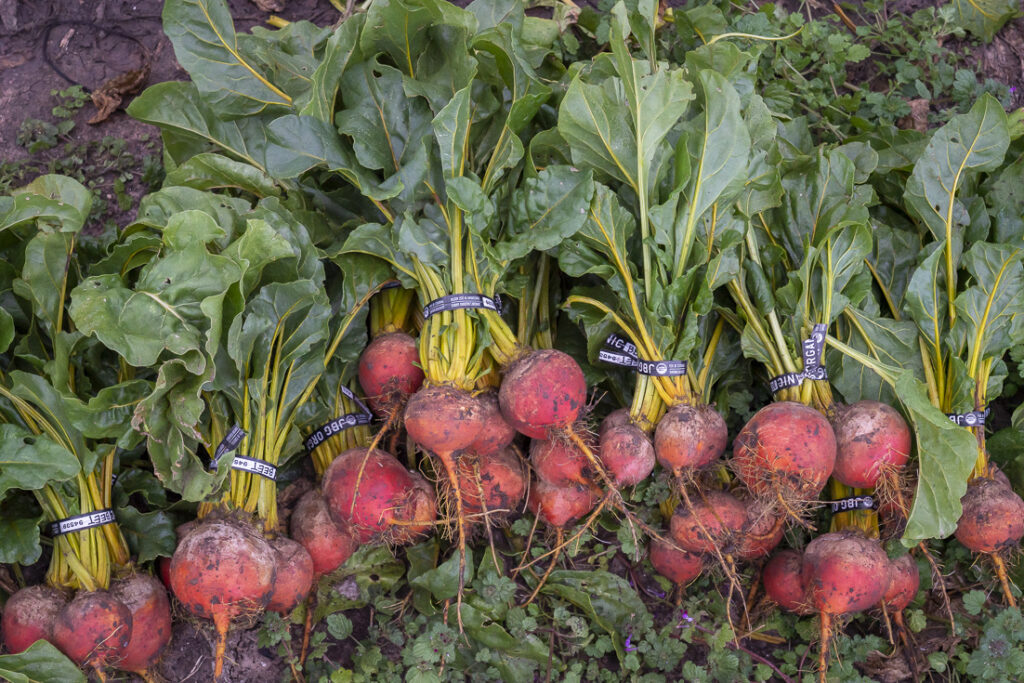 These golden beet greens are looking top notch. We love a bunched beet - it's truly two vegetables for the price of one. Photo by Scott David Gordon.
These golden beet greens are looking top notch. We love a bunched beet - it's truly two vegetables for the price of one. Photo by Scott David Gordon.
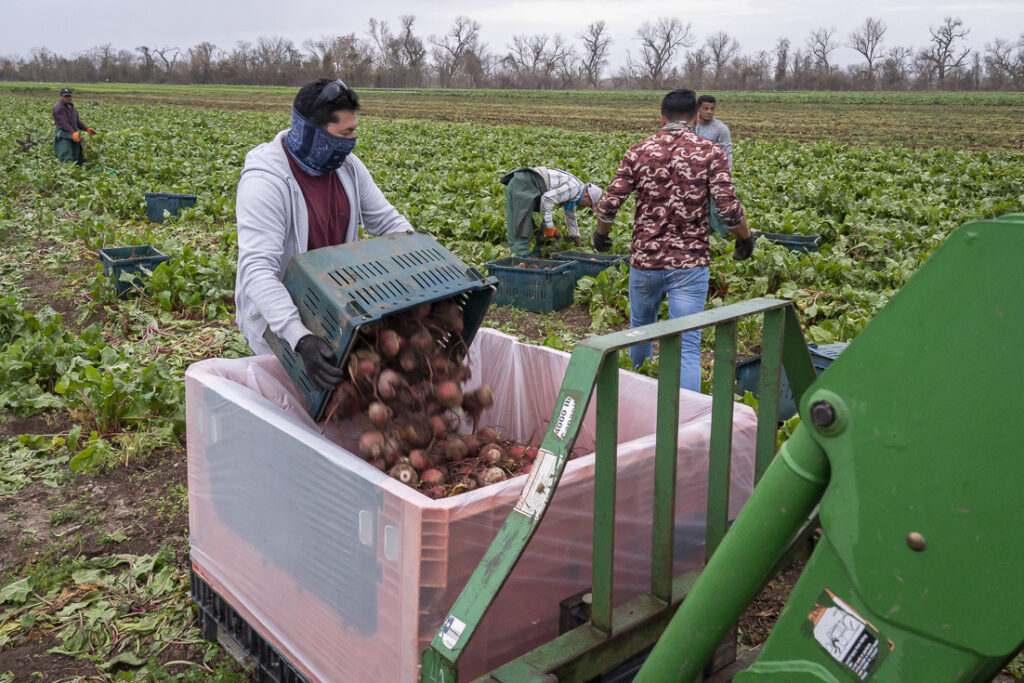 If the quality of the greens is less desirable, beets get "topped" and harvested in bulk. Luckily, a few insect holes in the greens doesn't bother the roots one bit. Photo by Scott David Gordon.
If the quality of the greens is less desirable, beets get "topped" and harvested in bulk. Luckily, a few insect holes in the greens doesn't bother the roots one bit. Photo by Scott David Gordon.
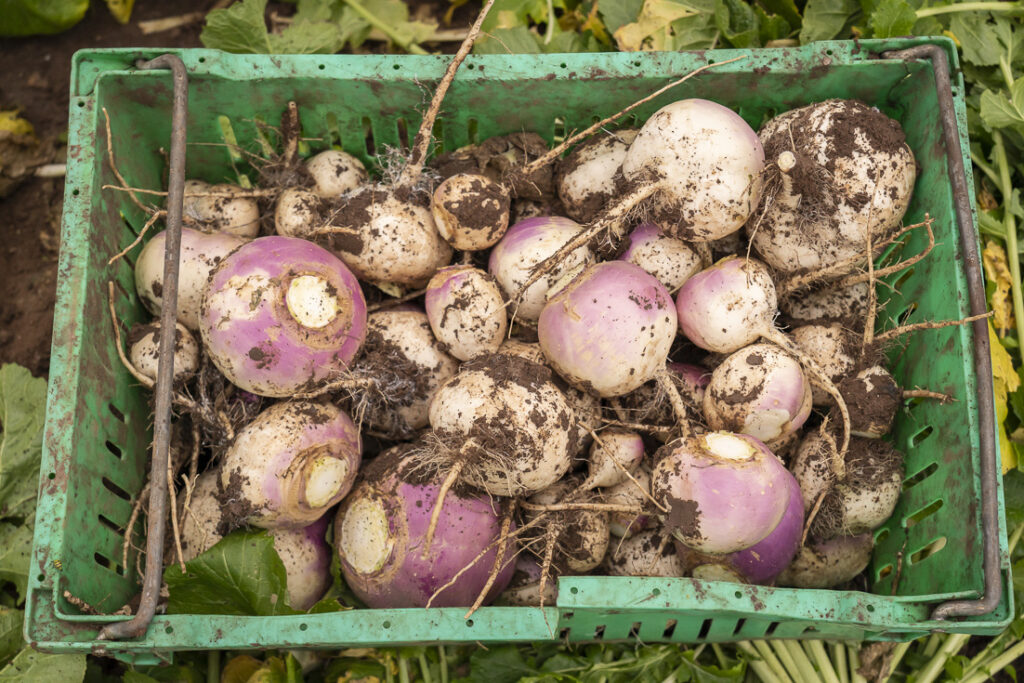 Purple top turnips in all shapes and sizes. Photo by Scott David Gordon.
Purple top turnips in all shapes and sizes. Photo by Scott David Gordon.
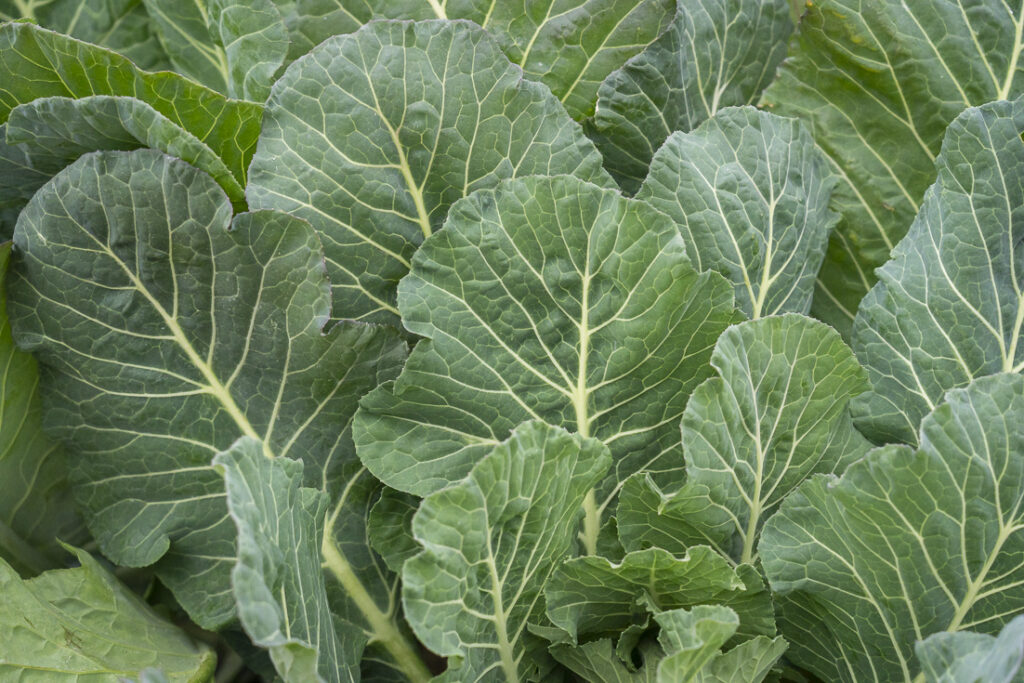 Collard fans. Photo by Scott David Gordon.
Collard fans. Photo by Scott David Gordon.
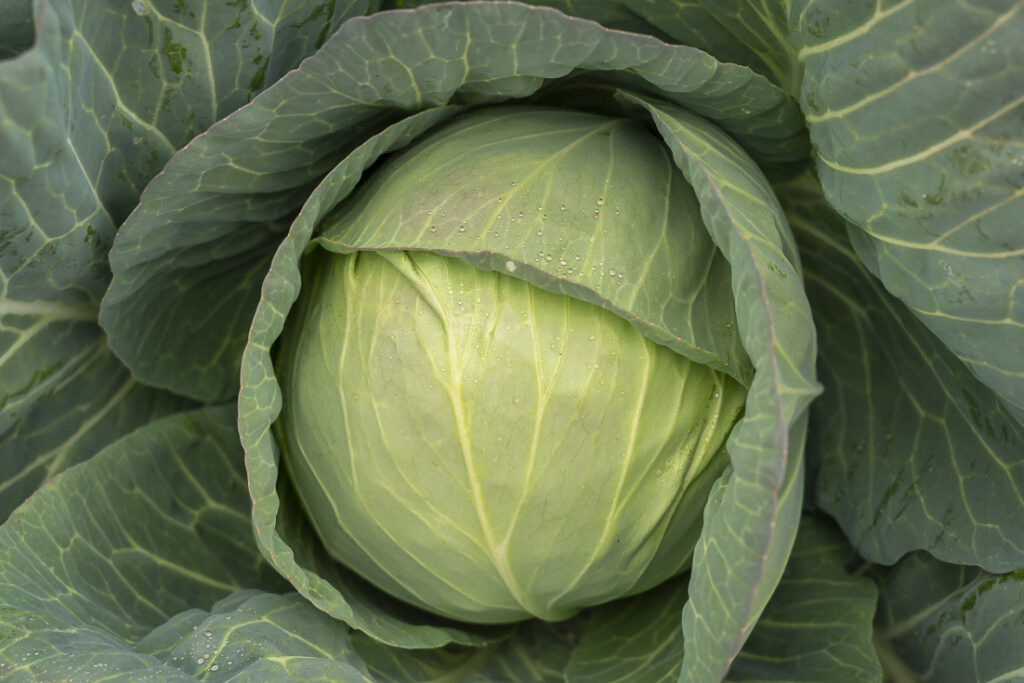 Did you read last week's blog post on brassicas? DId you know that a head of cabbage is just an enlarged terminal bud? Photo by Scott David Gordon.
Did you read last week's blog post on brassicas? DId you know that a head of cabbage is just an enlarged terminal bud? Photo by Scott David Gordon.
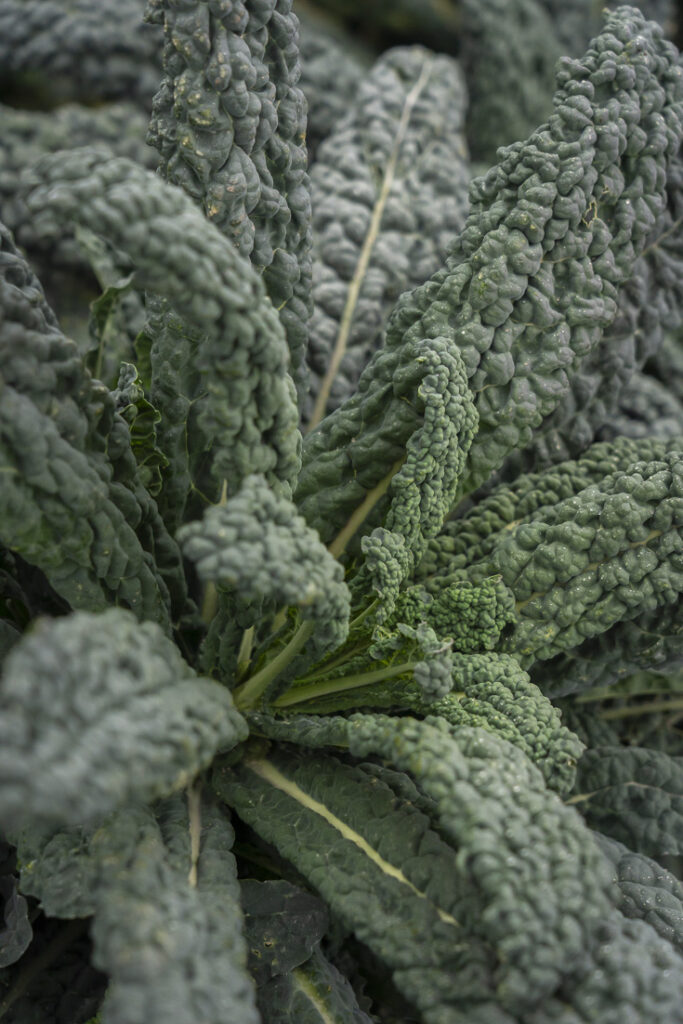 Speaking of Brassicas, believe it or not, this dino kale and a head of green cabbage are actually the same species of plant. Whereas the cabbage was selectively bread for a large bud, kale was bred for large leaves. Photo by Scott David Gordon.
Speaking of Brassicas, believe it or not, this dino kale and a head of green cabbage are actually the same species of plant. Whereas the cabbage was selectively bread for a large bud, kale was bred for large leaves. Photo by Scott David Gordon.
 The kale that keeps on giving. These kale plants have been harvested off of throughout the whole fall and winter season, and there is plenty more to go. Photo by Scott David Gordon.
The kale that keeps on giving. These kale plants have been harvested off of throughout the whole fall and winter season, and there is plenty more to go. Photo by Scott David Gordon.
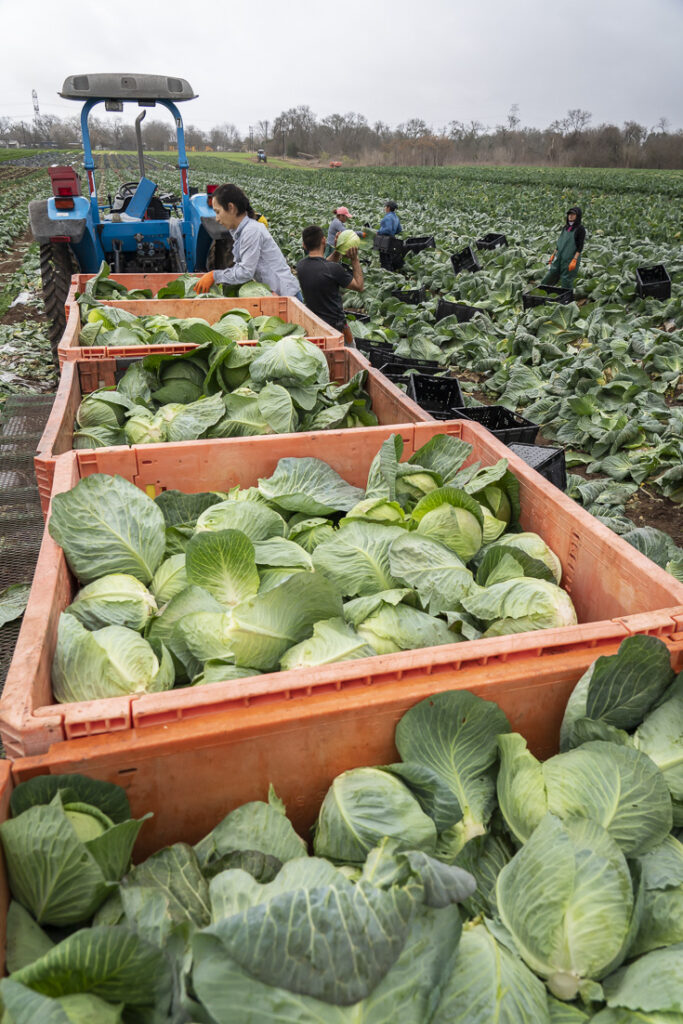 Cabbage patch women. Photo by Scott David Gordon.
Cabbage patch women. Photo by Scott David Gordon.
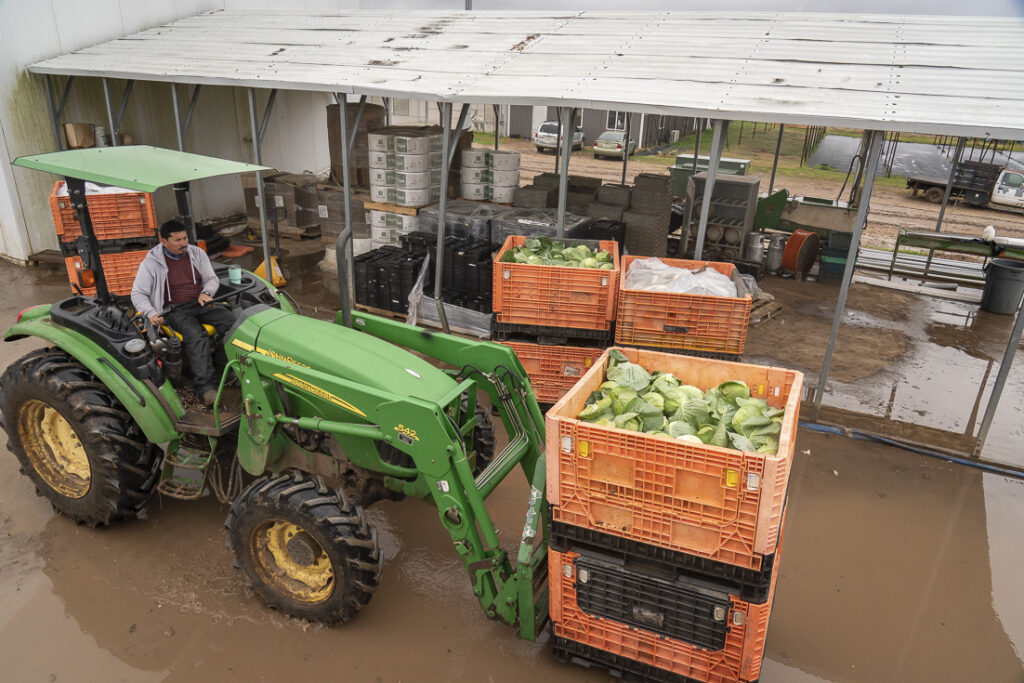 Vicente uses the John Deere to skillfully stack the bulk bins of cabbage before loading them into the cooler. Photo by Scott David Gordon.
Vicente uses the John Deere to skillfully stack the bulk bins of cabbage before loading them into the cooler. Photo by Scott David Gordon.
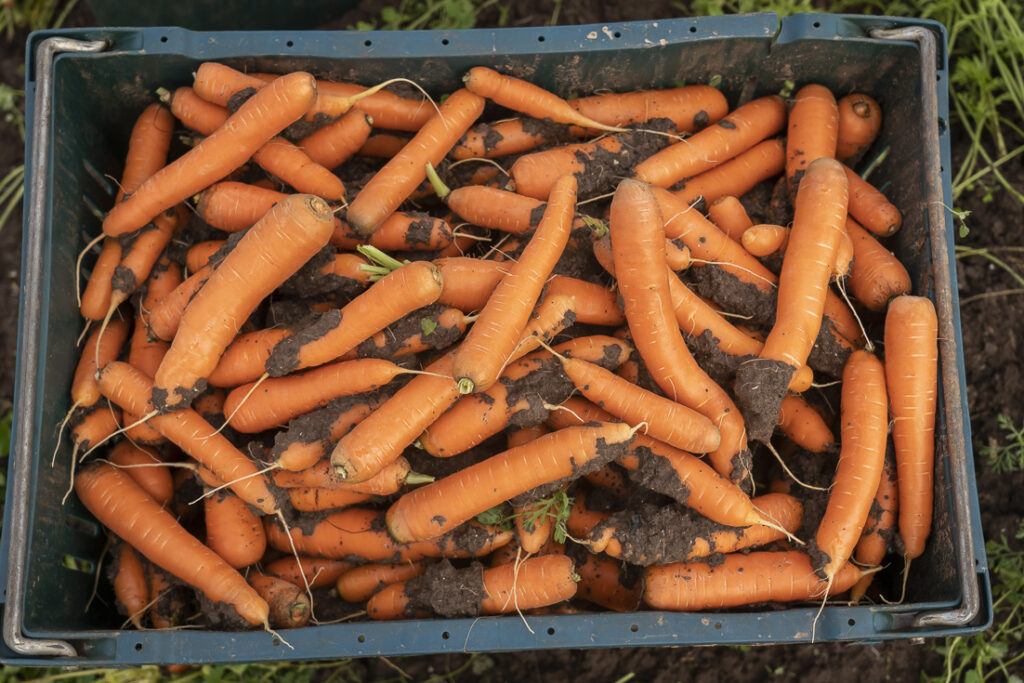 So orange, they almost look fake. Photo by Scott David Gordon.
So orange, they almost look fake. Photo by Scott David Gordon.
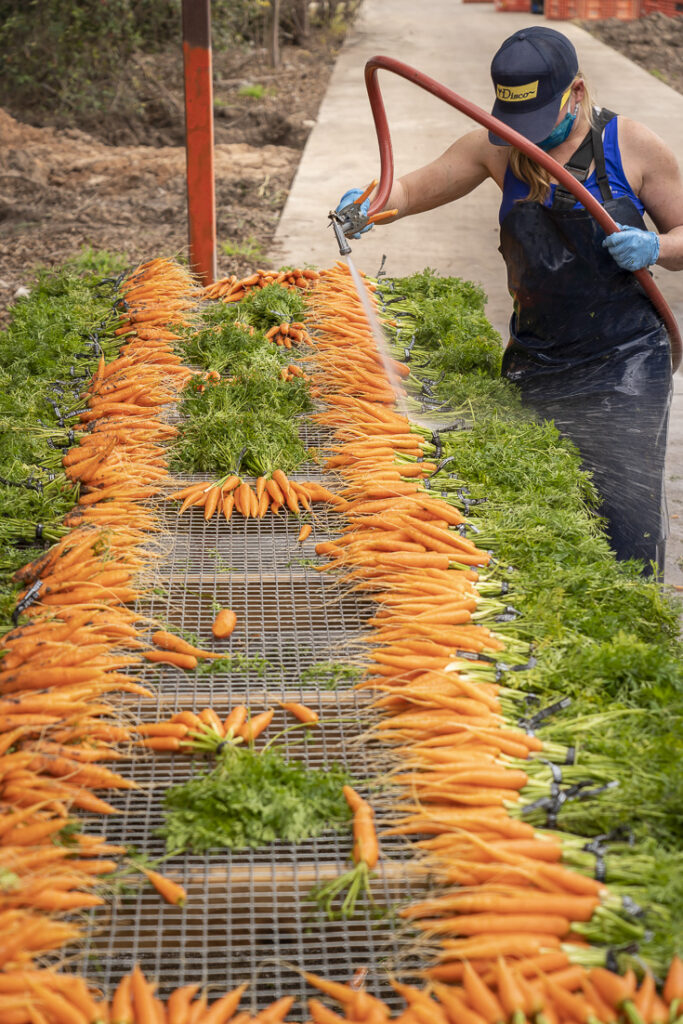 Ginger in ultimate carrot concentration. Photo by Scott David Gordon.
Ginger in ultimate carrot concentration. Photo by Scott David Gordon.
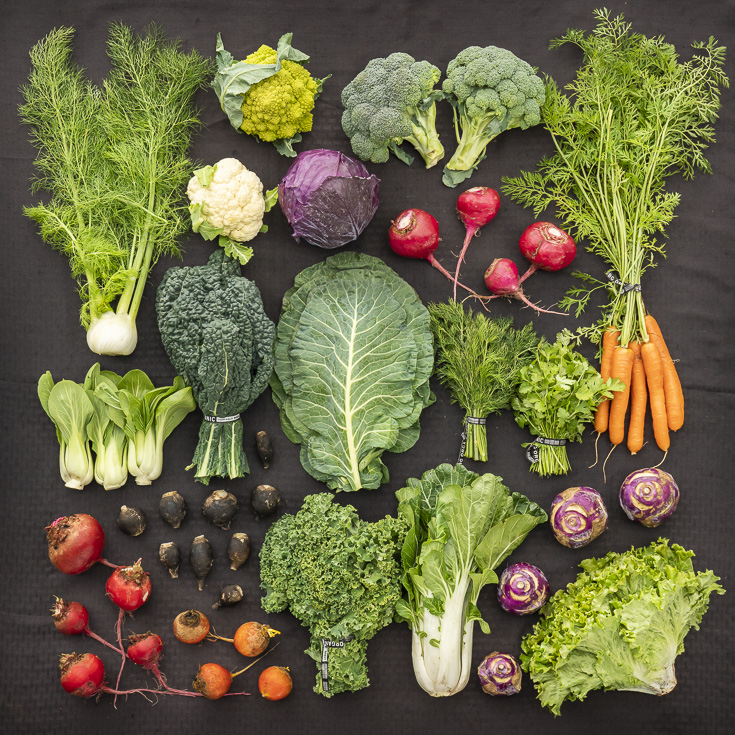 CSA box dreams. Photo by Scott David Gordon.
CSA box dreams. Photo by Scott David Gordon.
CSA BOX CONTENTS WEEK OF JAN 25TH
01/22/21 — Farm
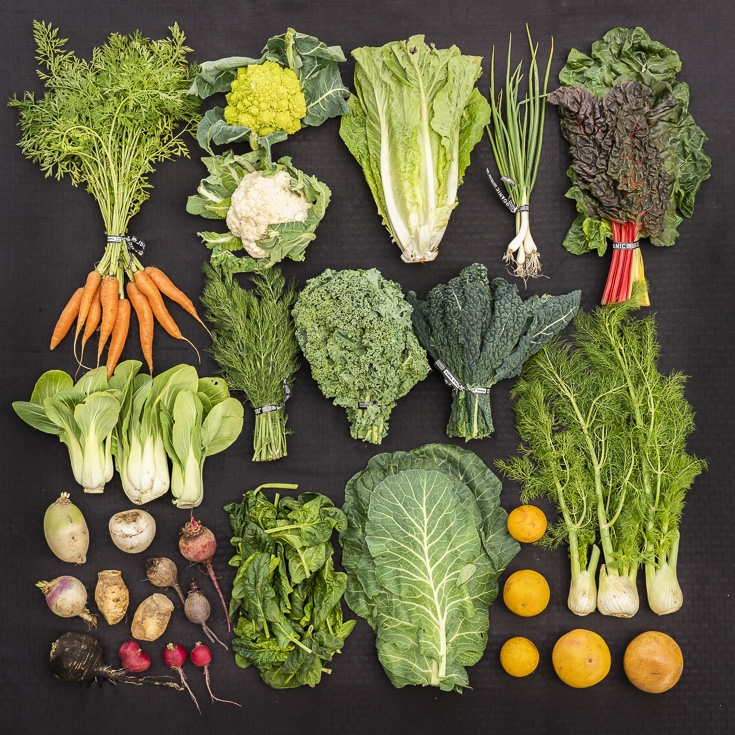 CSA Box Contents Week of Jan 25th
CSA Box Contents Week of Jan 25th
Large:
Fennel
Cauliflower
Roasting Bag
Carrots
Onions
Farmer's Choice, Green
Farmer's Choice, Herb
Baby Bok Choy
Collard Greens
Dinosaur Kale
CSA BOX CONTENTS WEEK OF JAN 25TH
01/22/21 — Farm
 CSA Box Contents Week of Jan 25th
CSA Box Contents Week of Jan 25th
Individual: Cauliflower, Romaine, 2lb Carrot, Roasting Bag, Dinosaur Kale
Small: Cauliflower, Romaine, Carrot, Bok Choy, Swiss Chard, Beet, Dinosaur Kale
Medium: Fennel, Cauliflower, Roasting Bag, Carrot, Romaine, Onion, Farmer's Choice Herb, Baby Bok Choy, Swiss Chard, Dinosaur Kale
Large: Fennel, Cauliflower, Roasting Bag, Carrots, Onions, Farmer's Choice Green, Farmer's Choice Herb, Baby Bok Choy, Collard Greens, Dinosaur Kale
ISAAC'S FAVORITE BLT
01/28/21 — Ada Broussard
 Recipe & Photos by Heydon and Isaac
Recipe & Photos by Heydon and Isaac
This recipe is a classic in our kitchen and one that Isaac loves to create and eat every single time. When the scent of bacon wafts through the air in our little casita, well, needless to say, I get excited to chow down, too. We received the most epic head of lettuce in our CSA box this week and wanted to showcase it in something besides a salad. Thus, Isaac’s favorite BLT was one of our dinners this week. Integrating high-quality vegetables in those everyday snacks and simple meals like the sandwich-for-dinner can really revolutionize the way you eat and truly heightens the caliber of your meals, or at least I think so. We are definitely looking forward to the JBG summer tomato iteration of this BLT, but in the meantime, we utilized some off-season orange cherry tomatoes.
Ingredients:
- 1 Red Onion
- A handful of cherry tomatoes (or one big tomato, use what you have)
- 1 Glorious head of JBG lettuce
- Bunch of Oregano
- Olive Oil
- Salt and pepper
- Bacon
- Mustard
- Mayo
- Bread
How to: Get a bread you like, preferably something fairly soft and thinly sliced. According to Isaac, “it ain’t about the bread for this sammy”. Slice red onion paper thin and loosely chop 2 to 3 beautiful JBG lettuce leaves. Slice tomato (JBG is not in season so Isaac used some sweet yellow cherry tomatoes) into fourths. And now, for the *secret ingredient* to Isaac’s personal favorite BLT - “if you’ve never had it this way, well, get ready for your mouth to explode!” - loosely chop a few sprigs of FRESH oregano.
Set all ingredients on a cutting board and drizzle in olive oil. Lightly grind salt and pepper on ingredients as well. Bake 6 pieces of Kiolbassa hickory bacon in the oven at 350-375 until crispy. Get 2 bread slices, spread a small amount of Colman’s mustard on each piece, and then spread a healthy amount of either Hellman’s or Duke's Mayo on each piece.
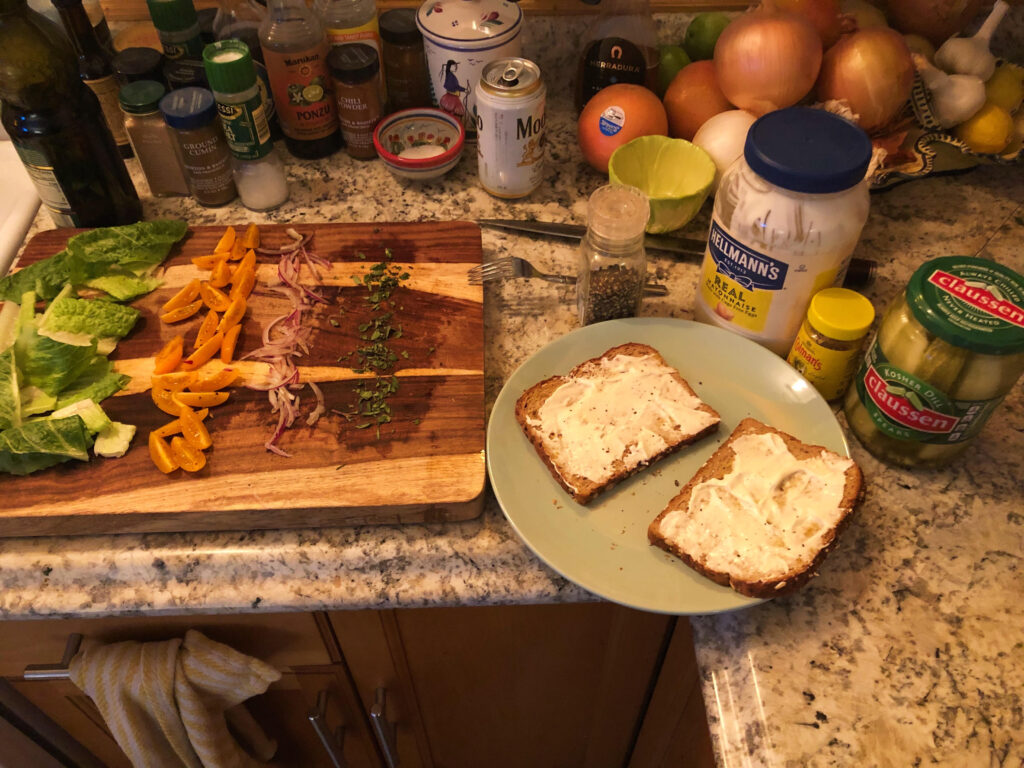
Begin the stack: red onion and a few punches of oregano, then lettuce, then tomato. Hit this layer with a little grind of pepper. Then add 2 or 3 pieces of bacon and repeat. On the second stack of bacon place them in the opposite direction (if horizontal the first time - stack vertical on the second layer). Cut the sandwich in half or diagonally, whatever gets you going, and ENJOY! Oh, and pair with some Claussen dill pickle spears for good measure. Yum.
A BRIEF HISTORY OF CSAS IN THE UNITED STATES
01/29/21 — Ada Broussard
In 2004, Brenton Johnson grew the biggest backyard garden of his life. This garden, in fact, overtook his front, side, and back yards. Initially, Brenton sold the first official JBG produce at SFC’s Downtown Farmer’s Market, but soon after that, Brenton started our CSA Program. The neighbors, after all, were curious and wanted to know how they could sample some of the produce they had been admiring from the Holly Street sidewalk. This early iteration of our CSA had just 30 members, and its origins inspired our farm’s name as well as our nearly 17-year CSA history! But, where did CSA Programs, themselves, originate?
![]()
The earliest roots of CSA Programs in the United States can be traced back to Dr. Booker T. Whatley (pictured below), a horticulturist, author, and professor at Tuskeegee University in Alabama. In addition to advances in the field of regenerative agriculture, horticulture, plant breeding, cover cropping (and so much more), Whatley published what he called the “10 commandments” for a successful farming enterprise. One such commandment was the idea of a “Clientele Membership Club” in which members paid upfront for a portion of a farmer’s harvest. By signing up members at the beginning of a season, farmers are able to pay for necessary season-starters like seeds and equipment…. without having to take out a loan from a bank. Sound familiar? Whatley’s model included options for Pick-Your-Own memberships, and both the CSA and Pick Your Own movements of today can thank Whatley for his ingenuity in the 1960’s and 70’s.
![]() Booker T. Whatley
Booker T. Whatley
After graduating from Alabama A&M University with a B.S. in agriculture, Whatley was drafted into the Army during the Korean War where he traveled to Japan and managed a hydroponic farm that was established to feed the U.S. troops in the area. In 1957, Whatley finished his service and enrolled at Rutgers University where he earned a doctorate in horticulture. (In 1989 he earned a law degree from Alabama A&M, as well). At around the same time Whatley was developing his Clientele Membership model, women in Japan founded the Teikei system - another cooperative-based system that connected farmers directly with consumers. During this same period, farm cooperatives and mutually-supportive systems of agriculture were gaining popularity in Europe, largely influenced by Rudolph Steiner’s writings on the subject.
In 1986, a farm in Massachusetts called Indian Line Farm was established as well as one in New Hampshire called Temple-Wilton Community Farm, both of which used the term CSA, or Community Supported Agriculture, for the first time. Many cite these two farms and their European influence as the origins of the CSA Model in the United States, an attribution that grossly overshadows Whatley’s contributions and ingenuity which blossomed years before. Sadly, this overshadowing is a common theme for BIPOC farmers in our country. It should be no surprise that we’re superfans of the CSA Model, and we aim to shed some light on the true history of this farming model. And maybe we’re the only ones who geek out on the history of CSA models? The remarkability of Dr. Booker T. Whatley is hard to deny, however. We’re looking forward to a bountiful spring, which is almost here. This season, we raise our farm coolers to Whatley - without whom the CSA movement may have not taken off in the United States. If you're a CSA member reading this, we hope you know how genuinely thankful we are for your decision to support our farm and our Community Supported Agriculture program. There are around 100 farm employees and around 200 acres of farmland that are grateful for your support. As always, thanks for reading!
![]()
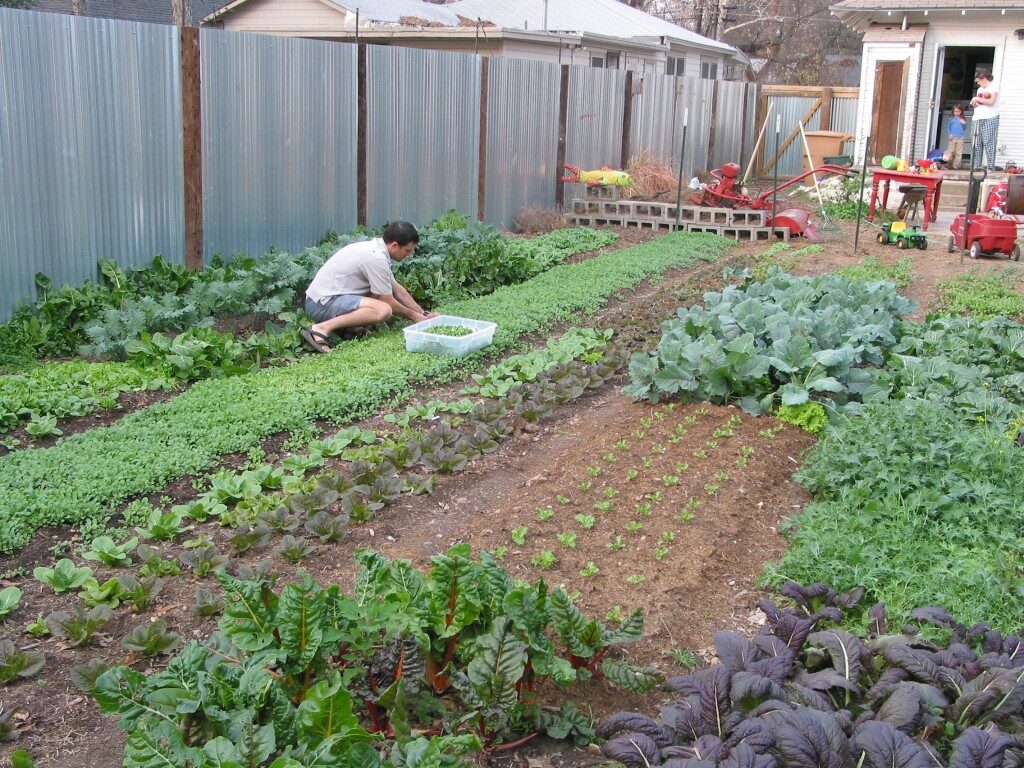
The earliest roots of CSA Programs in the United States can be traced back to Dr. Booker T. Whatley (pictured below), a horticulturist, author, and professor at Tuskeegee University in Alabama. In addition to advances in the field of regenerative agriculture, horticulture, plant breeding, cover cropping (and so much more), Whatley published what he called the “10 commandments” for a successful farming enterprise. One such commandment was the idea of a “Clientele Membership Club” in which members paid upfront for a portion of a farmer’s harvest. By signing up members at the beginning of a season, farmers are able to pay for necessary season-starters like seeds and equipment…. without having to take out a loan from a bank. Sound familiar? Whatley’s model included options for Pick-Your-Own memberships, and both the CSA and Pick Your Own movements of today can thank Whatley for his ingenuity in the 1960’s and 70’s.
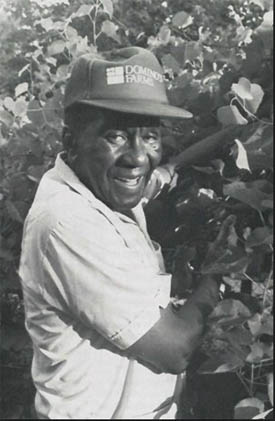 Booker T. Whatley
Booker T. Whatley
After graduating from Alabama A&M University with a B.S. in agriculture, Whatley was drafted into the Army during the Korean War where he traveled to Japan and managed a hydroponic farm that was established to feed the U.S. troops in the area. In 1957, Whatley finished his service and enrolled at Rutgers University where he earned a doctorate in horticulture. (In 1989 he earned a law degree from Alabama A&M, as well). At around the same time Whatley was developing his Clientele Membership model, women in Japan founded the Teikei system - another cooperative-based system that connected farmers directly with consumers. During this same period, farm cooperatives and mutually-supportive systems of agriculture were gaining popularity in Europe, largely influenced by Rudolph Steiner’s writings on the subject.
In 1986, a farm in Massachusetts called Indian Line Farm was established as well as one in New Hampshire called Temple-Wilton Community Farm, both of which used the term CSA, or Community Supported Agriculture, for the first time. Many cite these two farms and their European influence as the origins of the CSA Model in the United States, an attribution that grossly overshadows Whatley’s contributions and ingenuity which blossomed years before. Sadly, this overshadowing is a common theme for BIPOC farmers in our country. It should be no surprise that we’re superfans of the CSA Model, and we aim to shed some light on the true history of this farming model. And maybe we’re the only ones who geek out on the history of CSA models? The remarkability of Dr. Booker T. Whatley is hard to deny, however. We’re looking forward to a bountiful spring, which is almost here. This season, we raise our farm coolers to Whatley - without whom the CSA movement may have not taken off in the United States. If you're a CSA member reading this, we hope you know how genuinely thankful we are for your decision to support our farm and our Community Supported Agriculture program. There are around 100 farm employees and around 200 acres of farmland that are grateful for your support. As always, thanks for reading!
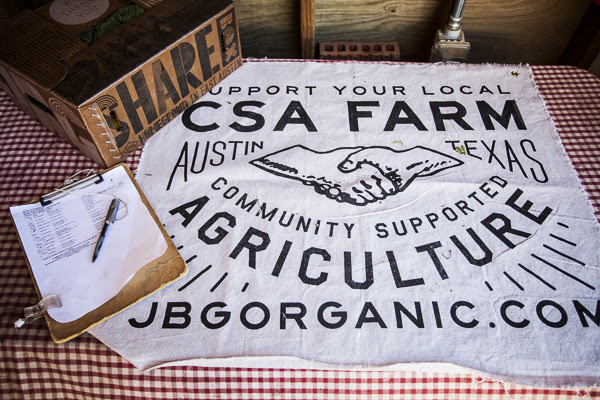
CSA BOX CONTENTS WEEK OF FEB 1ST
01/29/21 — Farm
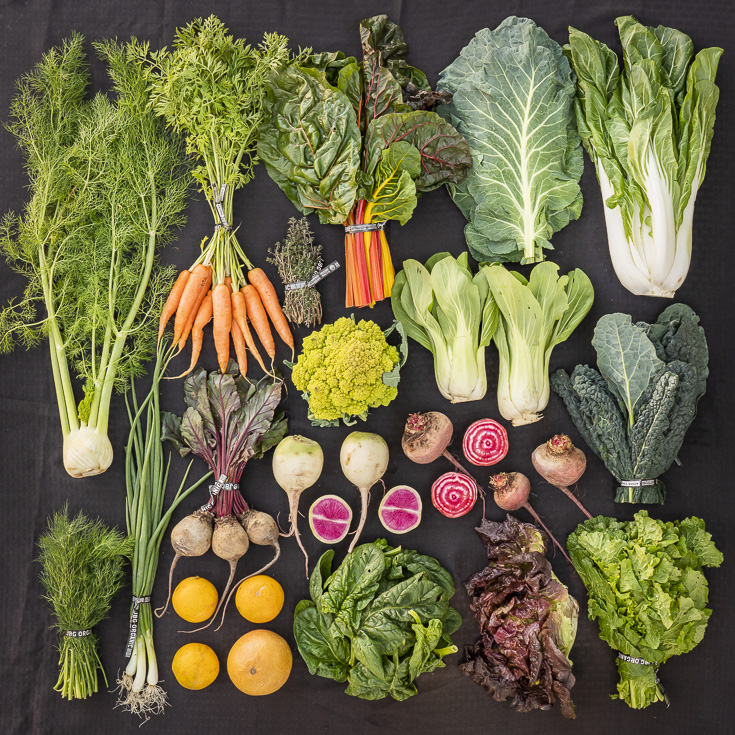 CSA Box Contents Week of Feb 1st
CSA Box Contents Week of Feb 1st
Large:
Cauliflower
Beets
Red Leaf
Fennel
Spring Onion
Farmer's Choice Herb
Cabbage
Mustard Greens
Carrot
Baby Bok Choy
Swiss Chard
Radish
CSA BOX CONTENTS WEEK OF FEB 1ST
01/29/21 — Farm
 CSA Box Contents Week of Feb 1st
CSA Box Contents Week of Feb 1st
Individual: Cauliflower, Beet, Carrot, Chard, Collard Greens, Baby Bok Choy
Small: Cauliflower, Roasting Bag, Dry Herb, Spinach, Mustard Greens, Spring Onion, Dinosaur Kale
Medium: Cauliflower, Beet, Red Leaf Lettuce, Fennel, Spring Onion, Dry Herb, Spinach, Collard Greens, Carrot
Large: Cauliflower, Beets, Red Leaf, Fennel, Spring Onion, Farmer's Choice Herb, Cabbage, Mustard Greens, Carrot, Baby Bok Choy, Swiss Chard, Radish






 0 ITEMS IN CART
0 ITEMS IN CART 

